The 1980s were a golden era for automotive design, introducing vehicles that combined exotic aesthetics with affordability. Many of these cars boasted unique designs inspired by high-end sports cars, allowing enthusiasts to turn heads without breaking the bank. Remarkably, some of these models were priced lower than the workhorse pickups of the day, making them accessible to a broader audience. This era proved that you didn’t need to spend a fortune to own a car that exuded style and performance.
This 1959 Rambler American Club Sedan was purchased by the seller in 2016, and since then it has been modified with air suspension, a 350ci Chevrolet V8, a TH350 three-speed automatic transmission, and a Ford 8” rear end. The exterior was shaved and customized with a louvered hood, tunneled headlights, and Chevrolet taillights, while the unibody was reinforced and fitted with rack-and-pinion steering, front disc brakes, and a triangulated four-link rear setup. Inside, bucket seats have been added along with white and red upholstery, a B&M shifter assembly, a Pioneer CD head unit, aftermarket gauges, and a decorative panel covering the rear seat area. Other highlights include 17” steel wheels, an Edelbrock 600-cfm carburetor, and a stainless-steel dual exhaust system with central outlets. This modified Rambler is now offered at no reserve with a clean Michigan title in the seller’s name.

The exterior trim and door handles were shaved during the build, and louvers were added to the hood. The corners of the hood and trunk lid were rounded, the headlights were tunneled, the windshield was replaced, and sport-style side mirrors, electric wipers, and LED lighting were installed. The PPG single-stage satin red urethane paint is contrasted by white pinstriping.

The bumpers were smoothed, the rear bodywork was modified with a recessed license plate box and ’54 Chevrolet taillights with custom lenses, and cutouts were added to the rear bumper to accommodate dual central exhaust outlets. The “Beep Beep” script on the tail panel is an homage to the song released by The Playmates in 1958.

Powder-coated 17×7” steel wheels wear polished hubcaps and are wrapped in 205/45 front and 225/50 rear Diamond Back redline tires. The seller tells us the tires and front air springs were replaced in 2024, and the air suspension is fed by a five-gallon tank linked to a VIAIR compressor. Custom-fabricated steel frame rails were added to the unibody, and the firewall, floors, and wheel tubs were constructed from 16-gauge sheet.

The front suspension was modified with a custom crossmember and power-assisted rack-and-pinion steering as well as spindles and 12” disc brakes sourced from a Ford Crown Victoria, while the Ford Maverick 8” rear axle features a triangulated four-link setup and drum brakes.

The reclining bucket seats were sourced from a Honda Civic and re-trimmed in white and red upholstery that carries over to the door panels. The dashboard fascia has been painted to match, and a center console was installed that houses a B&M shifter assembly and a Pioneer CD head unit. Insulation is said to have been installed under the black carpets. The wiring harness was assembled using Centech components.

The two-spoke steering wheel sits ahead of a Speedhut 120-mph GPS speedometer, while Sunpro auxiliary gauges have been added to the center of the dash. The digital odometer indicates 5k miles, though total mileage is unknown.

The rear seat has been removed, and a louvered panel extends from the parcel shelf to the back of the front seats.

The 350ci Chevrolet V8 was rebuilt prior to installation using an RV camshaft, and it is equipped with an Edelbrock 600-cfm carburetor, a Unilite distributor, finned valve covers, “rams horn” exhaust manifolds, and a stainless-steel dual exhaust system. The aluminum radiator is cooled by a belt-driven fan augmented by an electric fan. The seller notes a leak in the rear main seal.

The filler neck for the 14-gallon fuel tank is accessed in the trunk, which also houses the battery within a plastic enclosure.

Power is sent to the rear wheels through a TH350 three-speed automatic transmission and a custom driveshaft. A transmission oil cooler has been added.
The era of the Wagon is coming to an end. Volvo, the company which built its reputation on the legacy of its full-size estate cars, has confirmed the discontinuation of its famed V90 wagon and its lifted variant, the V90 Cross Country. The death of the Volvo V90 marks a significant shift for the brand as it shifts away from its traditional long-roof vehicles in favor of the more profitable and popular crossover SUV segment.
The End of an Era
The V90’s cancellation follows a predictable narrative in the current automotive landscape, where low-volume niche models are sacrificed in favor of more profitable offerings.
The current generation of the V90, based on Volvo’s Scalable Product Architecture (SPA) platform, was introduced in 2016. For the final model years in the United States, only the more rugged V90 Cross Country was offered, while the standard wagon was already discontinued.
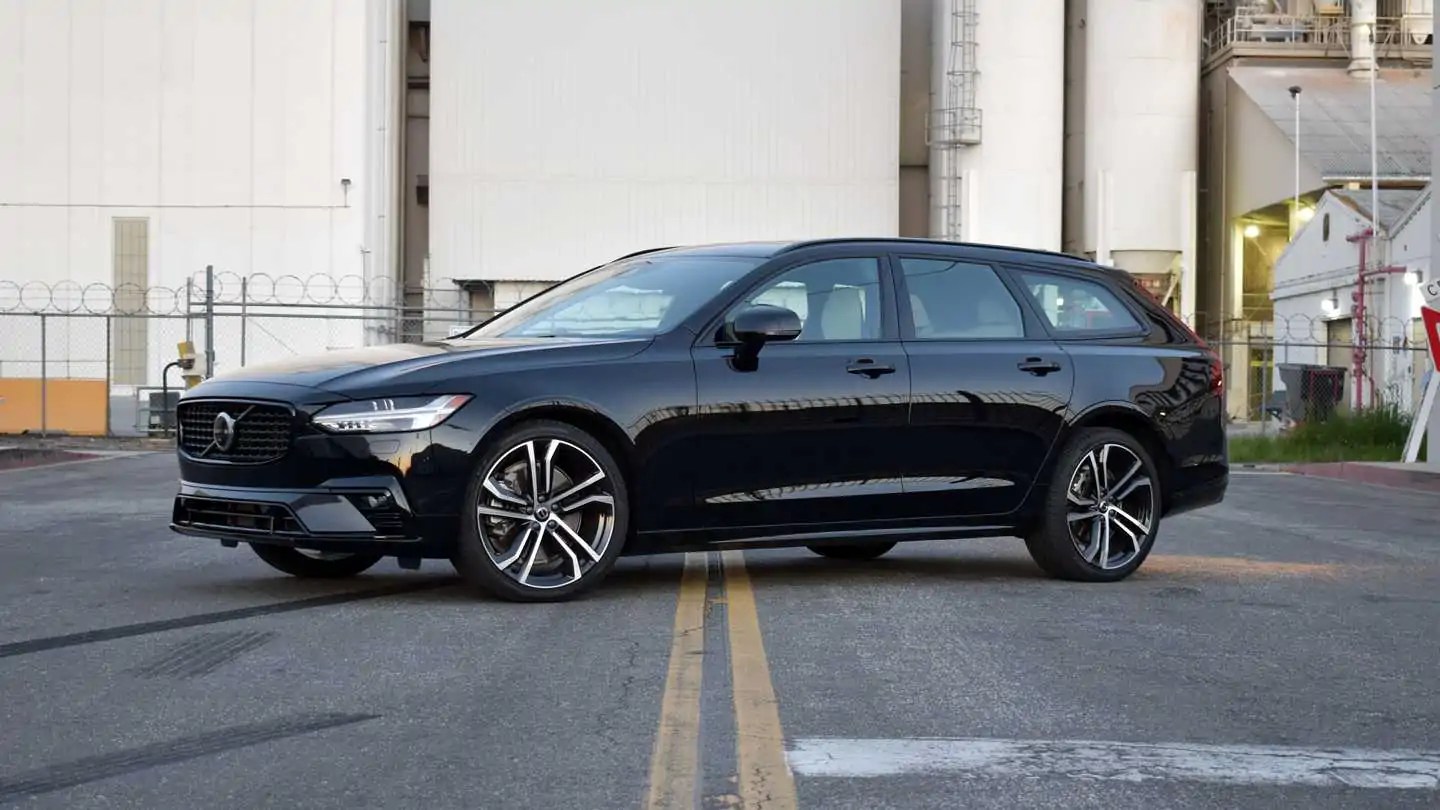
The discontinuation has been foreshadowed by previous statements from Volvo leadership. Former CEO Jim Rowan hinted at a future without wagons, and current management has proceeded with a product strategy focused on SUVs. The company is doubling down on more profitable, high-demand segments to reduce complexity and costs.
While the V90 was a well-regarded model, its sales figures were dwarfed by its high-riding stablemates. The V90’s fate is a direct result of market demand, which has heavily favored SUVs like the top-selling XC90.
The legacy of the Volvo wagon
For dedicated automotive enthusiasts, Volvo has long been synonymous with the station wagon, or “estate” car. Volvo’s wagons embody the brand’s belief that “people come first,” prioritizing user experience, safety, and utility, which has led to their status as functional yet stylish vehicles.
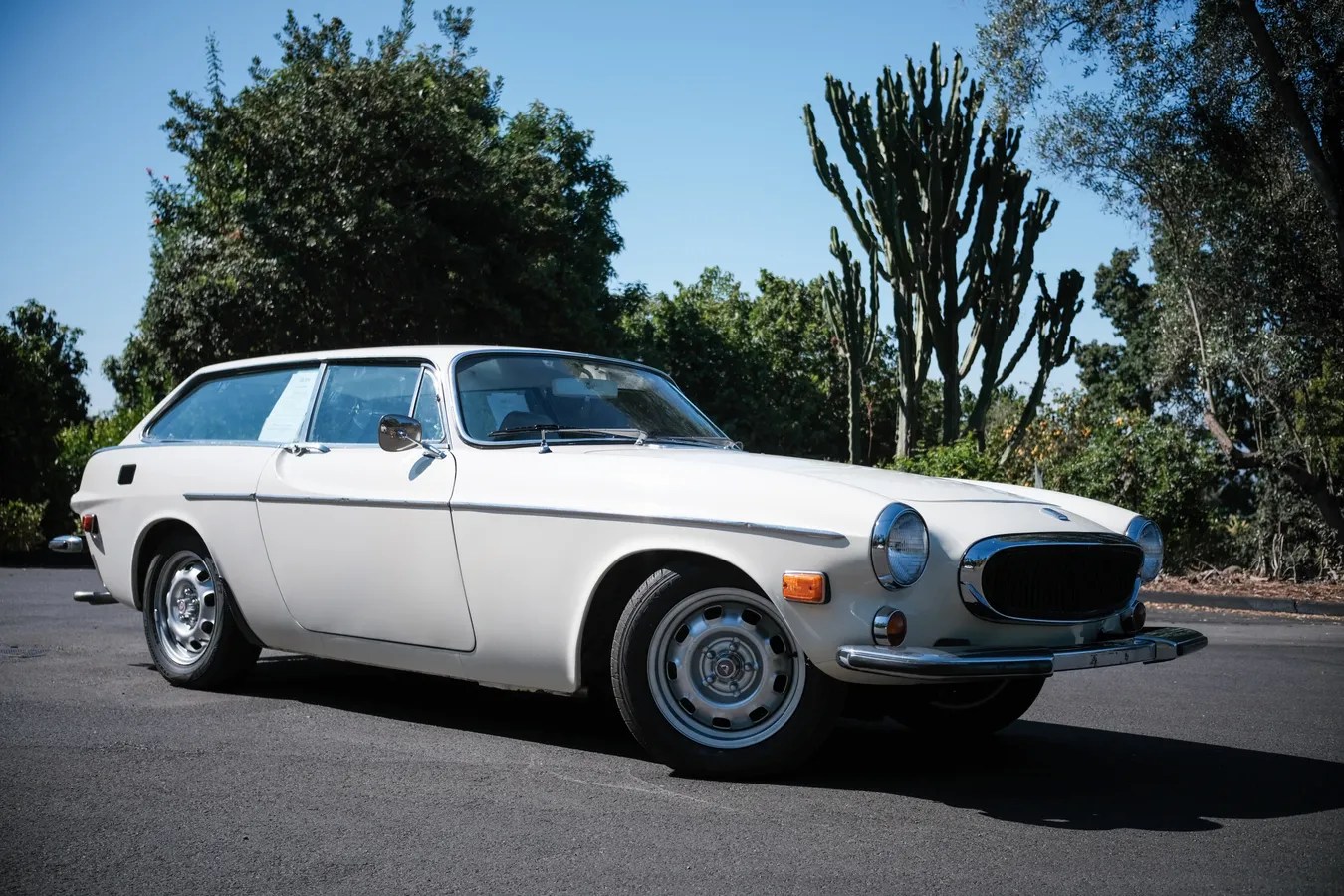
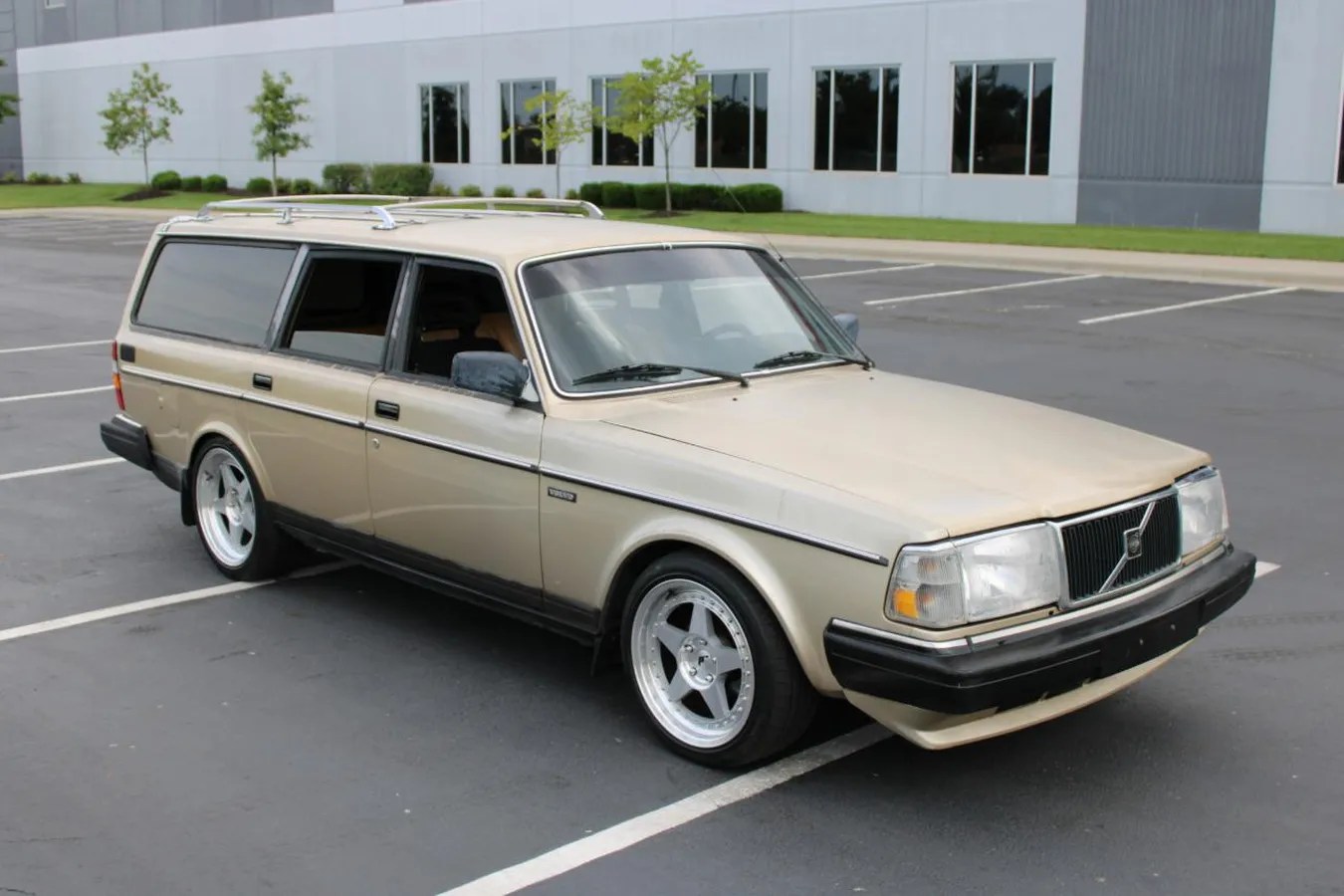
Volvo wagons began in 1953 with the Duett (“two cars in one”), a dual-purpose vehicle for both work and leisure. Other key wagon models include the more elegant Amazon in 1962, the classic 1962-1969 122S station wagon, and the iconic, long-running 240 Series from 1974 to 1993, which was a best-seller known for its durability and safety innovations. Volvo’s approach emphasized safety and utility over style, a philosophy that continues to define its “people-first” estate cars and has resulted in iconic models like the V90.
The latest V90 was praised for its elegant design, luxurious interior, and its ability to blend the utility of an SUV with the more engaging driving dynamics of a sedan.
A final farewell
The death of the V90 is a sad but pragmatic business decision. While it catered to a passionate audience of enthusiasts, the low sales numbers made its continued production unsustainable.
With the V90’s discontinuation, the smaller V60 Cross Country remains as the last Volvo wagon in the U.S. lineup. While Volvo confirmed its ongoing production for the near term, its long-term future in a segment with declining demand remains in question.
For those who still appreciate the uniquely Scandinavian, understated elegance and practicality of the modern full-size Volvo wagon, you’ll need to check with your local Volvo dealer for any remaining V90 stock. Or, for the lovers of gently used classic cars, check out Hemmings Marketplace, where you might just find your perfect Volvo wagon.
The post Volvo V90 Discontinued: A Look Back at the End of an Era appeared first on The Online Automotive Marketplace.
Ever since Nissan first rolled out its high-performance Z Nismo model, we’ve heard cries of protest circulating the internet. Upon its release, the 2024 Nissan Nismo disappointingly left out a manual transmission option, only offering a less-than-thrilling nine-speed automatic. Luckily, Nissan has been listening, and we’ve just heard confirmation that a manual transmission is coming to the Nismo model in the near future.
The current Nismo Z model sends power to the rear wheels via a nine-speed automatic transmission. Nissan said a manual transmission would not be an option because the majority of its customers desire a quick-reacting track car, and its proven that good modern automatics shift quicker than even the best manuals. Even though the automatic transmission, also equipped with a launch mode, was optimized to provide quicker shifting for a more “aggressive” feel, customers still crave the incomparable feeling of clutch action, hence Nissan’s change of tune.

A Manual Transmission Nissan Z Nismo is Coming
Nissan Americas chairman Christian Meunier recently confirmed during an Automotive News podcast that the company will soon add a six-speed manual option to the Z Nismo. This eagerly awaited update will bring the Nismo model in line with the standard Z’s available manual option, although we anticipate that the transmission will be specially modified to handle the Nismo’s extra 20 horsepower and 34 pound-feet of torque offered by its twin-turbocharged 3.0-liter V6.
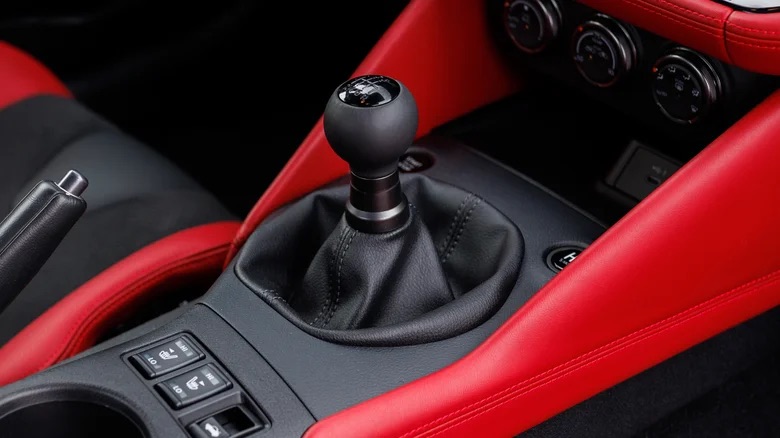
In total, the Nismo pushes 420 horsepower and 394 pound-feet of torque, which allowed Car and Driver test drivers to accelerate from zero to 60 miles-per-hour in a quick 3.9 seconds with the automatic transmission. Naturally, the manual transmission is likely to be a smidge slower, a small sacrifice for a more engaging driver-focused experience. The Nismo Z also gains a limited-slip differential, a stiffer suspension setup, stronger brakes, and more aggressive bodywork when compared to the standard Z.
The exact date of the manual transmission Nissan Z Nismo model’s release is unknown, though it is speculated it could arrive by the 2027 model year, so get ready for an even more engaging driving experience.
Nissan is Cranking Up The Fun
Nissan has been on a roll lately. Not only is it bringing back the manual transmission to the Z Nismo, it’s also working on reviving the iconic Silvia sports car, likely in hybrid or electric form. The company is also bringing back the Xterra, putting its Pathfinder back on a body-on-frame chassis, is reportedly coming out with a manual Infiniti sports sedan, and has reimagined the Leaf as a compact SUV EV for the 2026 model year.
Nissan also recently reimagined its mid-engine hot hatch concept from 2002. Meanwhile, students from the Nissan Automobile Technical College completed one-off custom creations in time to be displayed at the Tokyo Auto Salon. And, while the R35 generation Nissan GT-R production has ceased, the automaker assures us that the nameplate is here to stay.
The post Nissan Z Fans Rejoice: Nismo Manual Transmission Option Confirmed appeared first on The Online Automotive Marketplace.
In the world of unobtainable American automobiles, the Corvette Grand Sport is right up there with the Duesenberg SSJ and Shelby Cobra Daytona Coupe. The product of a secret project guided by the “father of the Corvette,” engineer Zora Arkus-Duntov, just five Grand Sports were produced.
Despite an intended run of 125 Grand Sports for homologation purposes, General Motors brass stopped the project in its tracks. GM was part of the AMA racing ban it had previously agreed to, along with its fellow Detroit automakers. The five cars produced, all among the most valued of American automobiles, remain tightly held in the hands of private collectors.
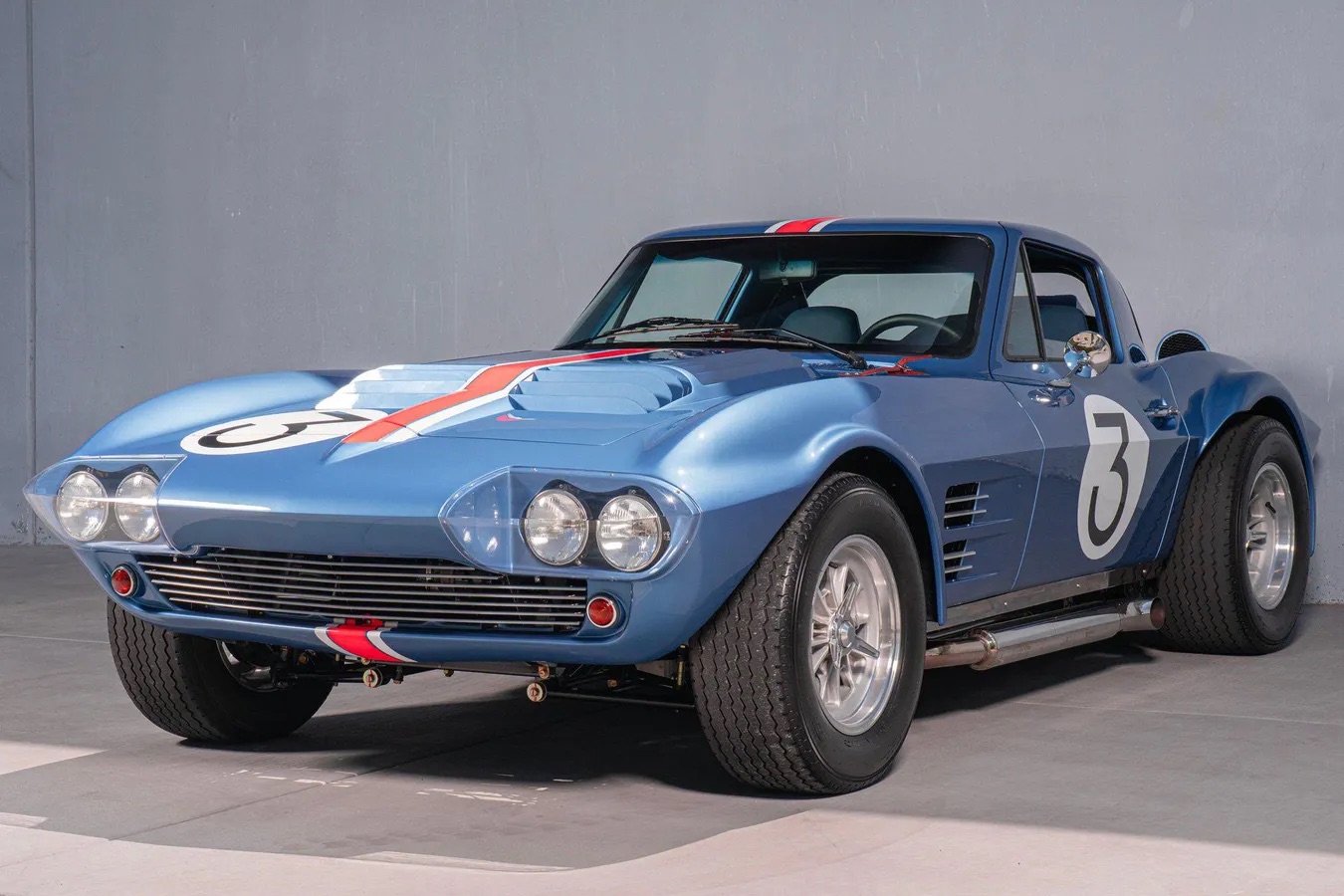
Fortunately, General Motors realized the error of its ways and now licenses Superformance to build replicas. From what we can tell, Superformance is the only company other than GM itself that is allowed to title its cars as Corvettes. This 1963 Chevrolet Corvette Grand Sport by Superformance is now listed on the Hemmings Marketplace. It looks a lot like the original and appears to be faithful in all the right ways. It also appears to take the right liberties for drivability and just a skosh of comfort and livability.
Lightweight Corvette Grand Sport
With the goal of the original Grand Sport to win in international sports car racing, Duntov and his crew set about removing well over a thousand pounds from the ’63 Sting Ray coupe. They replaced the original frame with a much lighter aluminum tube frame. A slightly smaller body was made from thinner fiberglass, saving additional weight, even with the big fender flares designed to clear the larger tires all around. Other aluminum components and magnesium wheels contributed to the Grand Sport’s lean ways. Fitted with an all-aluminum 377-cu.in. small-block V8 that breathed through four Weber carburetors, the Grand Sport weighed around 1,900 pounds.
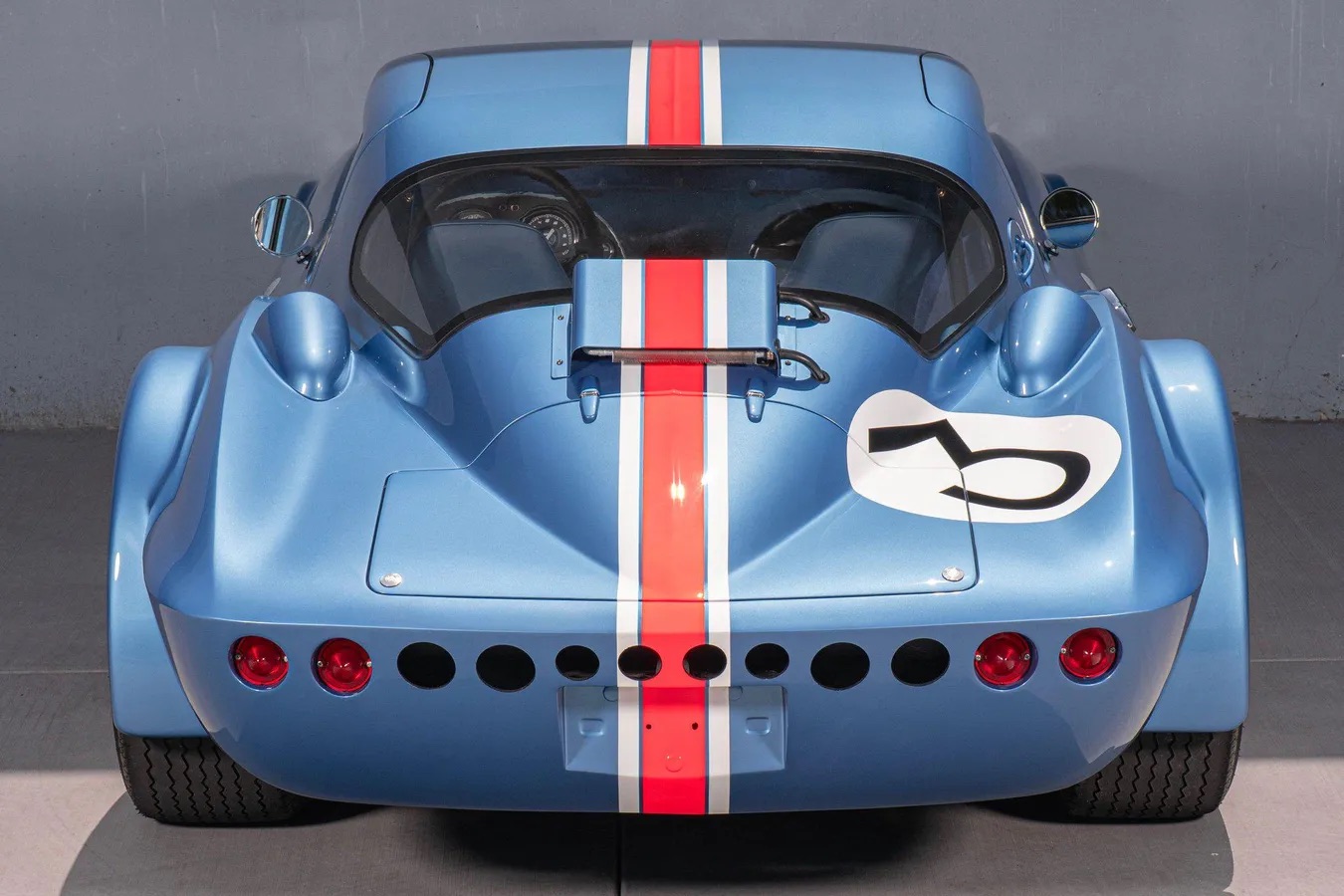
Limited Racing Success for the Grand Sport
Even with GM’s ban and a directive to crush the five existing cars, Duntov spirited several of the cars to privateer teams. After some teething problems were worked out and the cars were fitted with the potent 377 V8, the Grand Sports dominated the Cobras during Nassau Speed Week in 1963. Only the dedicated sports racers were faster. Not coincidentally, a number of Corvette engineers, ostensibly barred from participation by their bosses, conveniently decided to vacation in the Bahamas that week. Some of them may have even traveled with spare parts stuffed into their luggage amidst their swim trunks and sunglasses.
That was pretty much the end of the line for the Grand Sports, though some racing participation followed the next few year. All of the original cars are now in the hands of private collections or museums. They are all undoubtedly among the most valuable Corvettes extant, or even American collector cars for that matter.
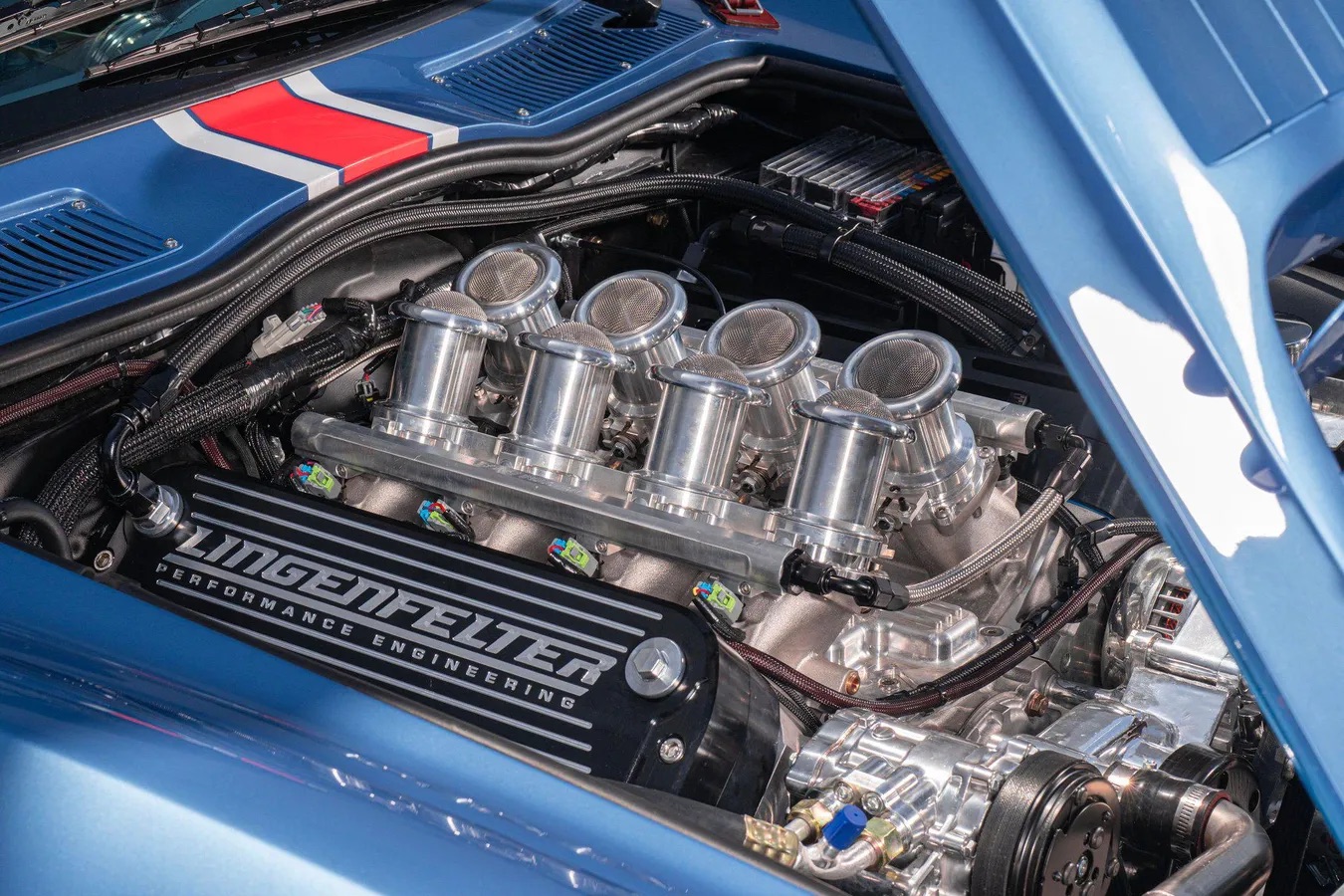
Superformance Revives the Grand Sport Legend
Now, with the Superformance version, an enthusiast can drive one without worrying about destroying a priceless piece of history. GM provided support for Superformance in terms of allowing access to original blueprints and molds. With an aluminum pushrod V8 engine and a manual transmission, the basics remain the same as the original. Still, Superformance has taken steps to modernize other areas of the car and make it street legal while still maintaining as much of the original Grand Sport experience as possible.
Powered by a 580-HP, Modified LS2 V8
The 1963 Corvette Grand Sport by Superformance now listed on the Hemmings Marketplace features a heavily modified LS2 V8. In the Corvette C6, Chevrolet rated the all-aluminum, 6.0-liter LS2 at 400 horsepower. In this reimagined Grand Sport, the 6.7-liter, Gen-IV small-block engine (408-cu.in.) wears Lingenfelter Performance valve covers. Atop the V8 is a Borla Induction intake setup with eight individual throttle bodies. It’s not four Webers, but it definitely gives the same racing vibe.
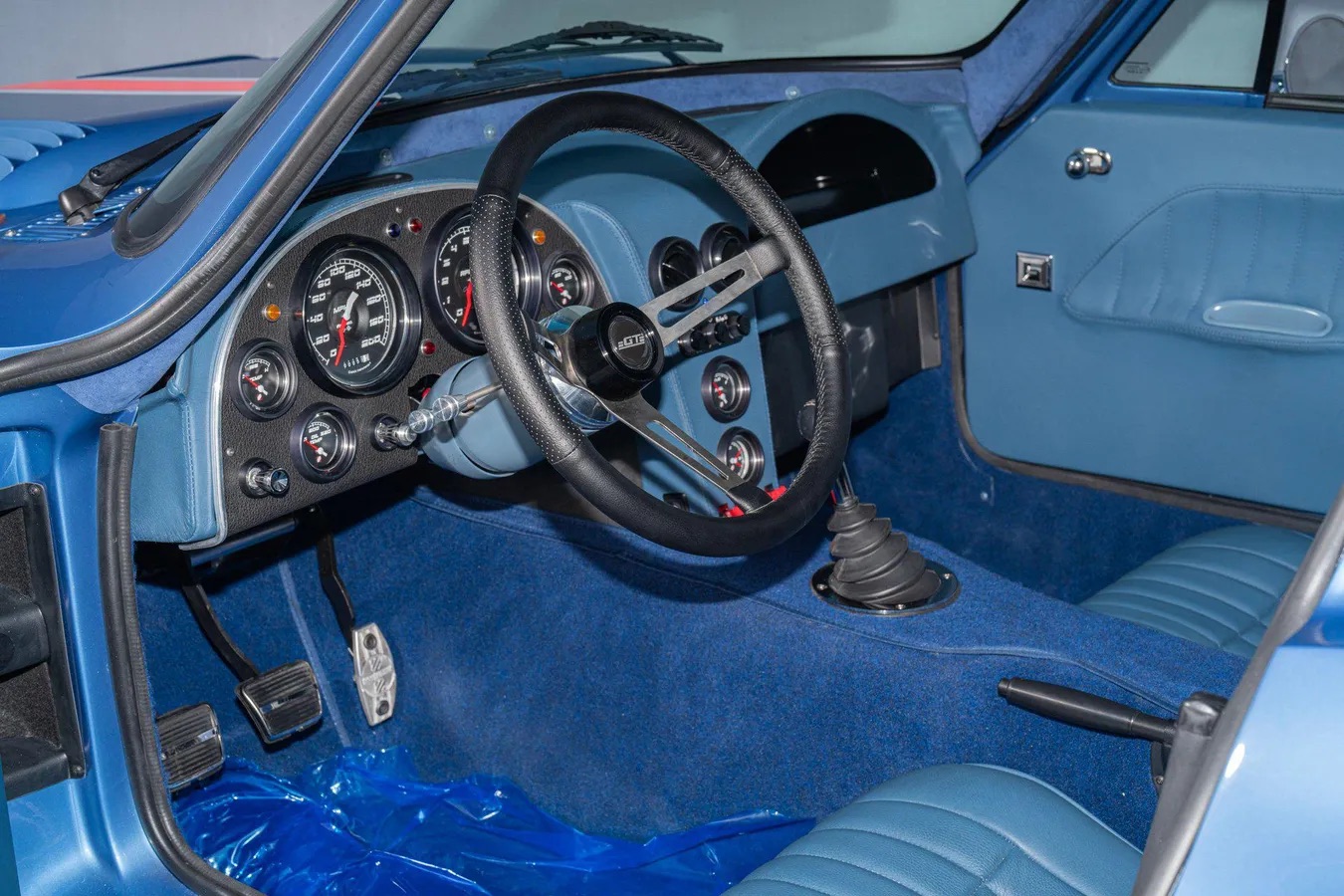
The listing notes an output of 580 horsepower that is routed to the rear axle via a Tremec T56 six-speed manual transmission. That’s the same gearbox that Chevrolet used in the LS2-equipped C6 Corvettes. Stainless-steel headers and side pipes complete the Grand Sport look.
Classic Corvette Grand Sport Livery
The distinctive Grand Sport body, with all its added flair—and actual flares—is finished in a period-correct Pelham Blue. A red center stripe, evocative of the “stinger” hood used on big-block C3s, starts at the rear and ends as a point at the front of the hood. The car wears the livery of the #3 car as entered at the Sebring 12 Hours in 1964 by the Johnson Chevrolet Company, a Texas dealership. Fifteen-inch “FIA-style” wheels with safety-wired center knockoffs complete the look.
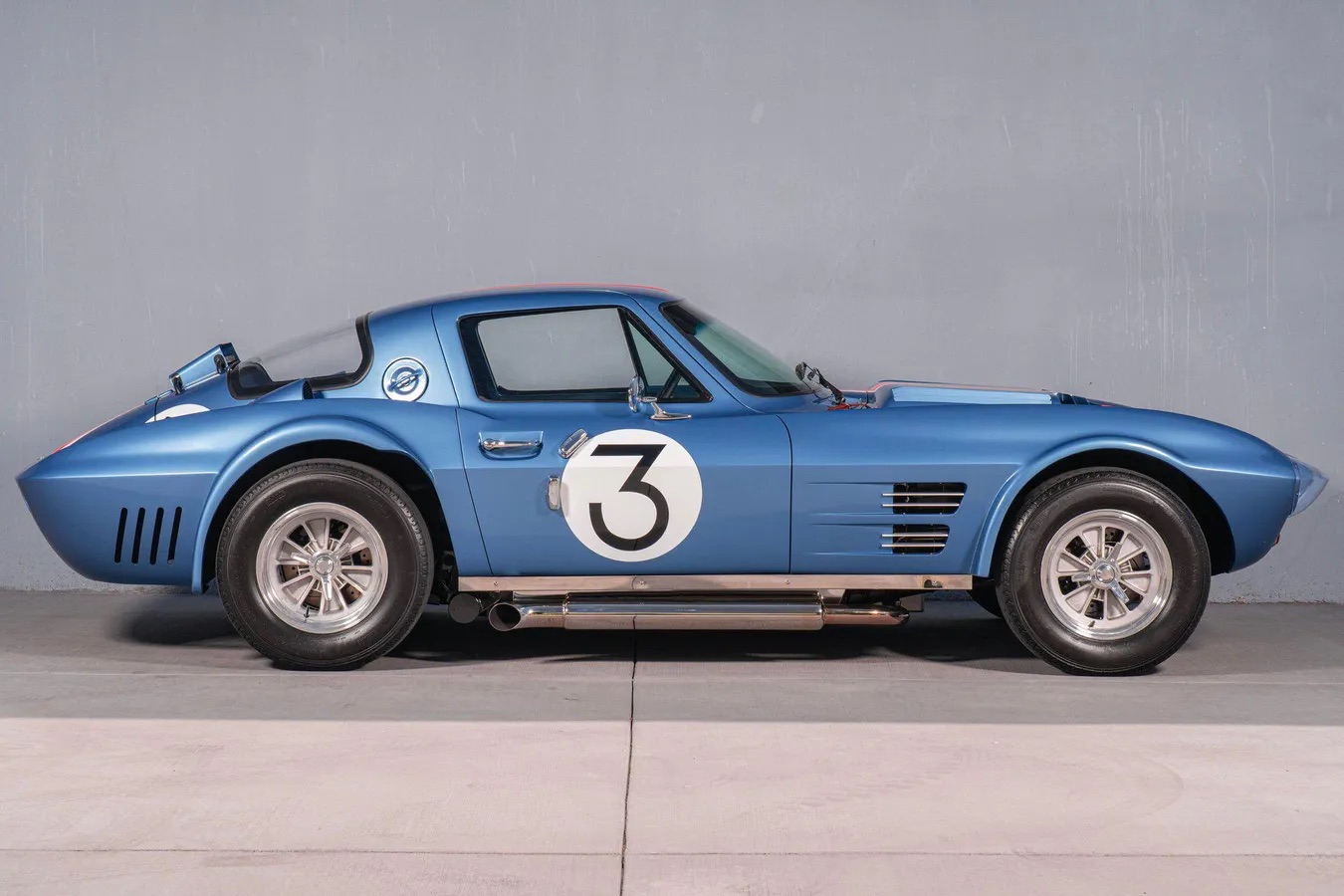
Superformance Updates to the Grand Sport
Where Superformance takes some liberties involves the fitment of a four-wheel fully independent suspension with Bilstein coilover shocks and H&R springs. Wilwood disc brakes are on all four wheels. Rack-and-pinion steering is also part of the package as is additional cooling, with an aluminum radiator and an oil cooler. Power windows and air conditioning are part of those modern upgrades to keep the Grand Sport pilot comfortable while channeling his inner Duntov.
It’s highly unlikely that anyone reading this piece will ever own an original Grand Sport. And even less likely that he will take a heavy-footed blast down the road in it. Yes, this 1963 Chevrolet Corvette Grand Sport by Superformance is not exactly cheap with a $299,950 asking price, but it’s accessible to high-end sports car aficionados. And it’s available and ready to be enjoyed.
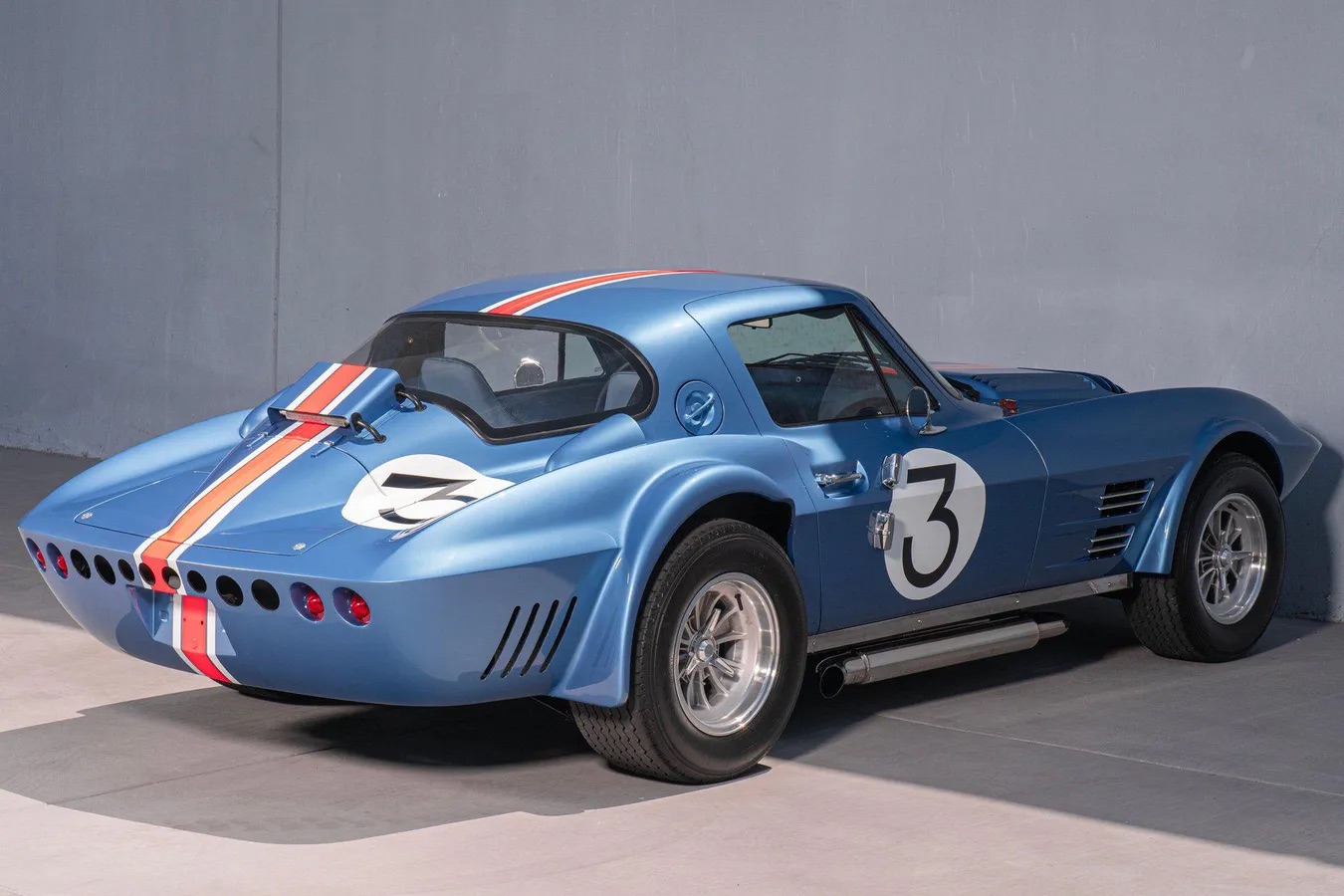
The post Grand Sport Redux: Superformance Corvette Now Available from the Hemmings Marketplace appeared first on The Online Automotive Marketplace.
Between the 1970s and 1990s, the automotive industry underwent significant transformations driven by evolving insurance regulations and safety standards. In 1971, the National Highway Traffic Safety Administration (NHTSA) introduced Federal Motor Vehicle Safety Standard No. 215, mandating that all new cars from the 1973 model year onward be equipped with front and rear bumpers capable of withstanding a 5 mph collision without damage to key components. (en.wikipedia.org) This regulation led manufacturers to design bulkier, less aesthetically pleasing bumpers, often resulting in vehicles that prioritized compliance over driver enjoyment. Additionally, the 1973 oil crisis and subsequent fuel efficiency mandates further influenced car designs, emphasizing economy and safety features that sometimes compromised performance and driving excitement. (en.wikipedia.org)
Barn finds and classic cars that were once loved, then forgotten in fields or tucked away in buildings often hold stories that tug on our heart strings. In this case, the collection of Mopar muscle cars is not forgotten, but instead holds memories for the man who owns them. In the below video, we get to take a peek at a crown jewel that is parked amongst the Plymouth Barracudas, ’Cudas, Dusters, and Road Runners left to rust – a 1971 ’Cuda with billboard stripes and a Shaker hood.
Parker, the host of YouTube channel Backyard Barn Finds, is a millennial enthusiast known for finding and restoring classic American muscle cars like Camaros and Mustangs. He and his team headed out to Gerald’s Pennsylvania property, where a plethora of Mopars in varying conditions are scattered throughout.
The ‘Cuda Barn Find Holy Grail
There are actually two 1971 Cudas on the property. This model year is the holy grail for Mopar collectors, with the lowest production numbers, the wildest styling and a wide array of factory options that had proud owners driving away with drag strip race-ready muscle cars.
Distinguishable by the shark gills and quad headlights, the 1971 Plymouth Cuda saw fewer than 500 examples factory-equipped with a shaker hood, mostly on Hemi-powered models. The example found by Backyard Barn Finds is exceptionally rare in that is equipped with a 383 cubic-inch V8 mated to a slapstick automatic. It also features power windows, leather buckets, rear defrost, and dash-mounted cassette deck, but in its current state of decay, only the most Mopar-fluent enthusiasts would give the muscle car a second look. In the video, Parker states that this is the rarest Plymouth Cuda he has ever found.
Mopar Memories
During a tour of the property, the owner introduces us to a 1973 Plymouth Barracuda, a muscle car which he bought used and drove as a senior in High School. He converted the car to a 340 cubic-inch pistol grip four-speed. Around that same time, he was fixing up a 1970 Plymouth Road Runner for his cousin, now equipped with a 440 six-pack, which still sits on his property.
We also see a 1970 Plymouth Road Runner V-Code equipped with a 440 Six Pack, still sporting its factory In-Violet finish, not to be confused with Dodge’s Plum Crazy hue. A 1972 Duster with a 340 engine mated to a four-speed transmission is parked nearby, plus a handful of 318-powered Barracudas that have a story of their own. Watch as Backyard Barn Finds uncovers these once-hidden Mopar gems:
In the beginning, the owner states that these cars are not for sale, but later in the video he states some of them “may be for sale.” Contact the Backyard Barn Finds YouTube channel if interested.
The post Backyard Barn Finds Unveils Rare 1971 Plymouth Cuda appeared first on The Online Automotive Marketplace.
If you’re not good at telling one brand’s engine from another, perhaps the color may help. In the case of Ford Motor Company products of a particular era, they were painted a certain shade of blue starting in the 1966 model year.
As part of a branding effort, Ford wanted you to know that the sign of quality under the hood was painted the same hue as the Blue Oval logo that was so familiar to many people since 1927. Of course, Ford’s marketing department didn’t tell you this streamlined the production process as well.
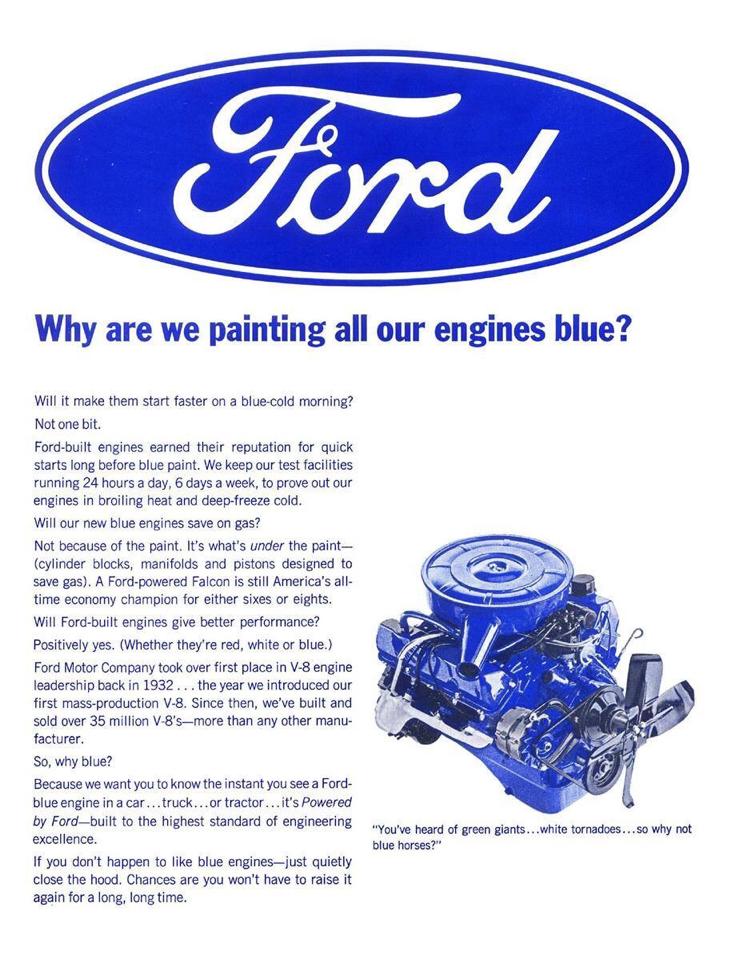
From what I can gather, the use of “Ford Corporate Blue” engine paint did not last beyond 1981, around the time when several platforms were modernized.
I’ve seen the above notice sporadically appear online over the years. I do not know if it came from Ford, but it certainly reads like it did.
In a May press release about the updated CR-V lineup, Honda said the “CR-V is America’s best-selling CUV over the last 28 years and continues to set sales records, surpassing 400,000 units last year—an all-time best for the model.” There are many reasons for the model’s popularity, some of which I covered in my review of the 2025 Honda CR-V Sport Touring Hybrid. Another one I’ve learned by driving an older model is that the CR-V is a great road trip vehicle.
I’ve been on a lot of road trips in my life in a variety of vehicles, but I think I’ve put the bulk of that kind of mileage on my mother-in-law Liz’s 2022 CR-V EX-L. When it comes down to it, my wife’s Mazda CX-5 isn’t as roomy on the inside and my Hyundai Sonata doesn’t have enough cargo space. Within just a few years, I’ve driven the CR-V from metro Phoenix to Sedona and Flagstaff, Las Vegas, and Carlsbad, California. That’s not even counting all the times I’ve been a passenger in it on the way to places such as Jerome, Arizona, and on the way back from El Paso. What’s made it such a go-to vehicle when it’s time for my wife, son, mother-in-law, and me to get out of town?
LOW-KEY STYLING
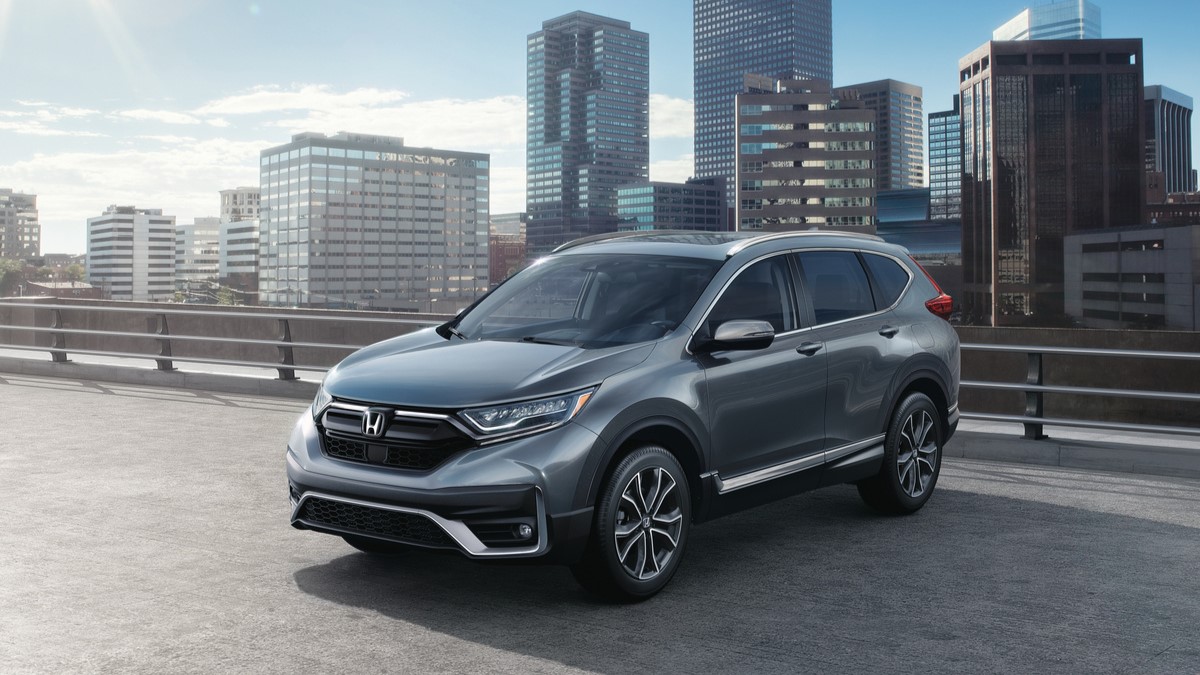
In many ways, the Honda CR-V is well-rounded. It’s not too pricey, not too indulgent, not too sporty. Visually, it strikes a similar balance. As a crossover, it’s essentially a two-box design, but it has enough angles and curves to make it a little more interesting. At the same time, it’s not what I’d call a flashy vehicle—even in its lustrous Radiant Red Metallic finish. It’s easy to make good time to your destination when you don’t have people coming up to you at gas stations to ask questions about what you’re driving.
FREAKISH CARGO CAPACITY
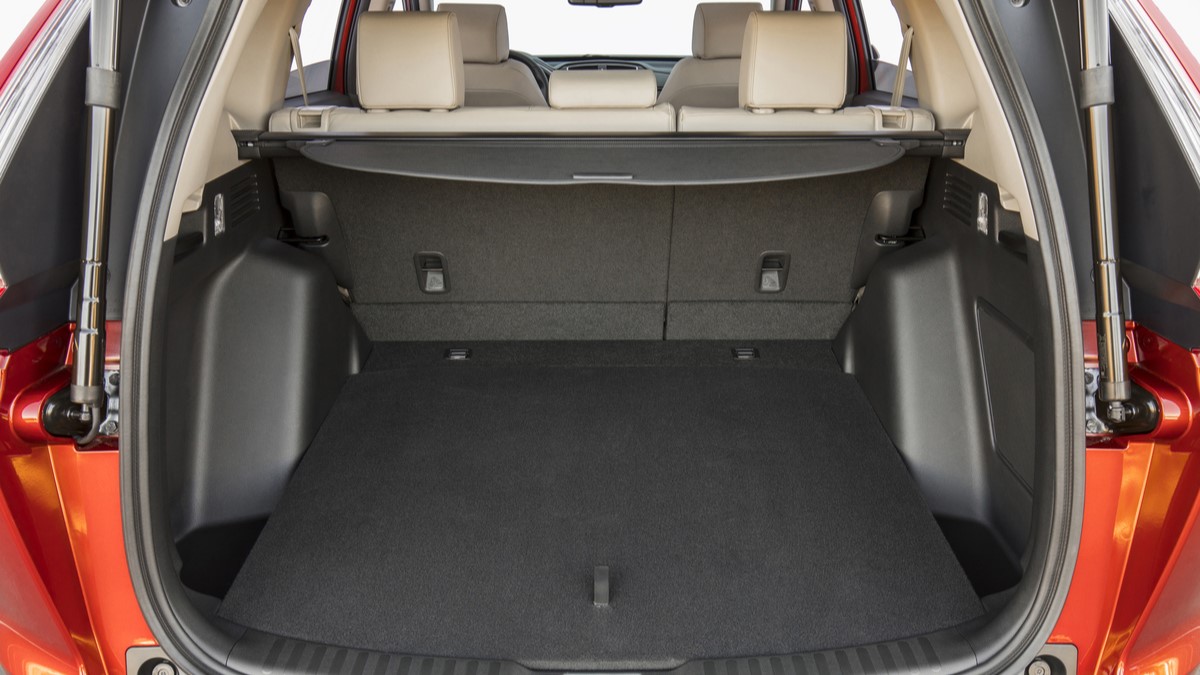
I was impressed by the CR-V’s ability to swallow luggage and gear before I ever drove it. My MIL and my late FIL Hugo used to go on trips in it and I remember Hugo would always pack an absolutely giant duffel bag as well as two desktop computer monitors so he could work remotely. By the time Liz added her stuff, the rear cargo area of the CR-V was stacked to the ceiling. Sure, the rearward visibility was reduced to zero, but I marveled at my in-laws using every single one of the CR-V’s 39.2 cubic feet of cargo space behind the second row. I was also impressed by the sheer amount of stuff such a modestly sized vehicle could hold. These days, the CR-V has no problem fitting my son’s smaller travel stroller and enough luggage for a short trip.
COMFORT FOR ALL
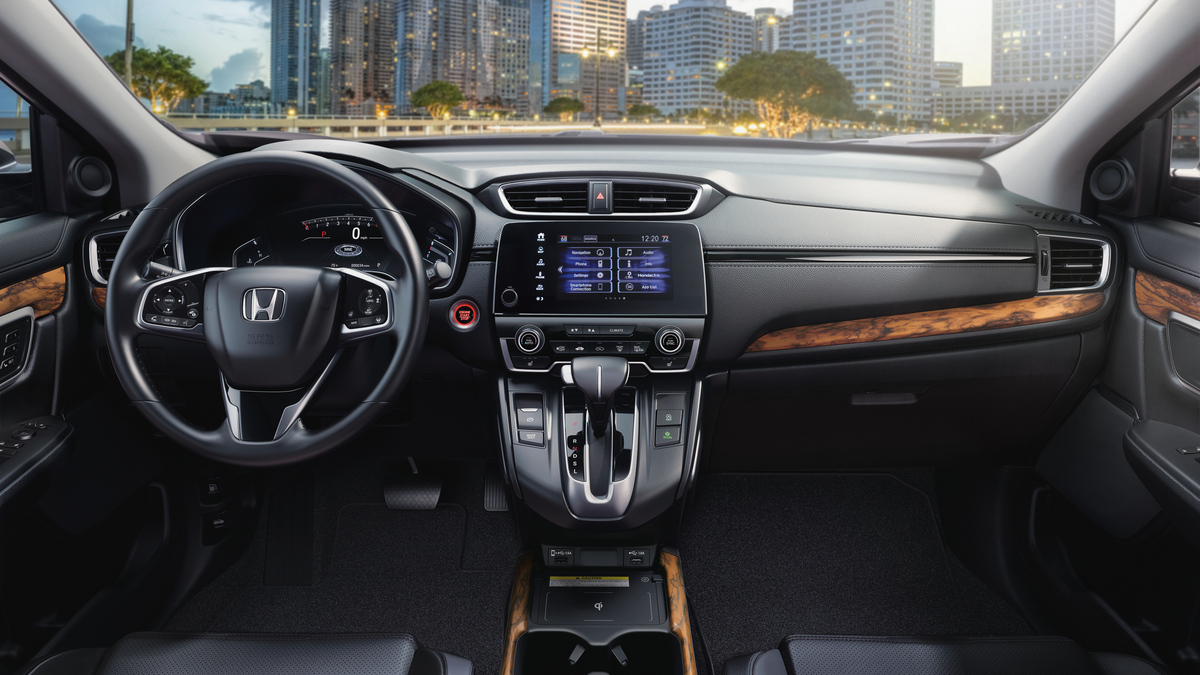
Both rows of the CR-V EX-L’s Gray leather interior are a pleasant place to be. Up front, there’s a leather-wrapped steering wheel with controls for the audio system and the adaptive cruise control (such a nice thing to have on an out-of-state trip), dual-zone automatic climate control, leather-wrapped shifter, Apple CarPlay and Android Auto, and Brake Hold (great for when the flow of traffic slows to a trickle). Even when my son Hayden is riding in his bulky car seat in the back, my wife still has enough legroom in the shotgun seat.
The second row offers adult-sized legroom, a pair of HVAC vents in the back of the center console, fold-down center armrest with cup holders, and reclining seatbacks.
PLEASANT RIDE QUALITY
Thousands of miles driving and riding in the CR-V has shown me just how well Honda set up its suspension. Even on rough roads (especially the one to Vegas), it’s gentle and compliant without feeling floaty or sloppy.
RESPECTABLE POWER
My MIL’s front-wheel-drive CR-V has a turbocharged 1.5-liter I4 under the hood. Factory-rated at 190 horsepower and 179 lb-ft of torque, and hooked to a CVT, it’s built for practicality, not speed. As modest as the CR-V’s engine may be, it’s never left me needing more, even on the uphill drive to Arizona’s “High Country.”
WALLET-FRIENDLY FUEL ECONOMY
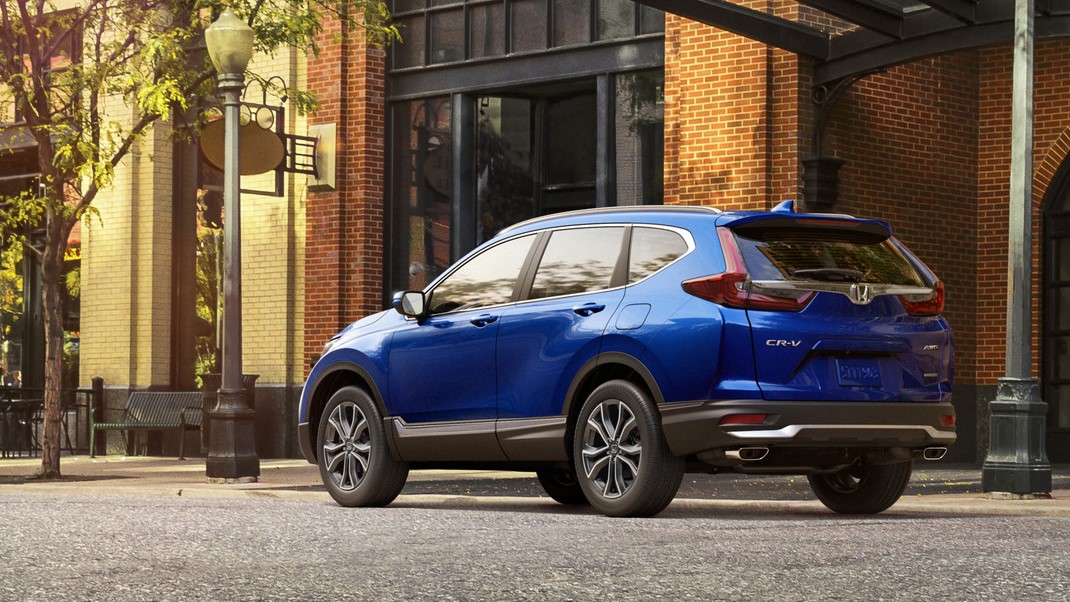
No matter how much I enjoy a long drive with my family, I don’t want to extend it with frequent stops to gas up. Luckily, the ’22 CR-V with FWD has fuel economy figures of 28 mpg in the city, 34 on the highway, and 30 combined. That means more time for pounding out the miles, but fewer chances to get a cold fountain drink (sorry, My Love!).
Given how low the mileage on my MIL’s CR-V is, I envision my multigenerational family taking several more road trips in it—until Hayden has a sibling. Then it’ll be time for me to get the minivan of my dreams.
Your vehicle’s cooling system is more than just a radiator, water pump, thermostat, fan, and coolant. Well, OK, it is exactly that, but there is a lot more to an effective cooling system than just the parts, they need to be matched to properly cool the engine (and transmission/oil) consistently without overheating. There are so many variables in cooling system design that can cause major headaches. You may think you have a serious engine issue, but you may just have the wrong radiator cap.
We spent some time speaking with Phil Cochran of U.S. Radiator in Gadsen, Alabama, about automotive cooling systems. U.S. Radiator has been building the best in radiators for over 50 years, using American-made parts and materials. When it comes to radiator and cooling system components, you really do not want to skimp on the quality, the life of your engine depends on it. If you have a project that you need assistance with keeping it cool, call U.S. Radiator at 800-421-5975 so their techs can help you solve the problem and get your temps down where they should be.
Are All Radiators The Same?
The simple answer is absolutely not. There are so many different styles and types of engine radiators, it can get confusing, but there are a few styles that are the most common. Prior to the 1980s, pretty much every radiator was made from a copper-brass alloy, which offers the best heat transfer rate. The problem with copper-brass (CB for short) is that the tubes have to be thicker and they use solder to bond each tube to the end plate. This makes CB radiator cores thicker, taking up more space. In the mid-80s, copper and brass became harder to get, so OEMs switched to aluminum radiators. Aluminum also conducts heat well, just not quite as well as CB. The difference is that aluminum tubes are much thinner, so you can fit more rows of tubes in the same space as a CB core.

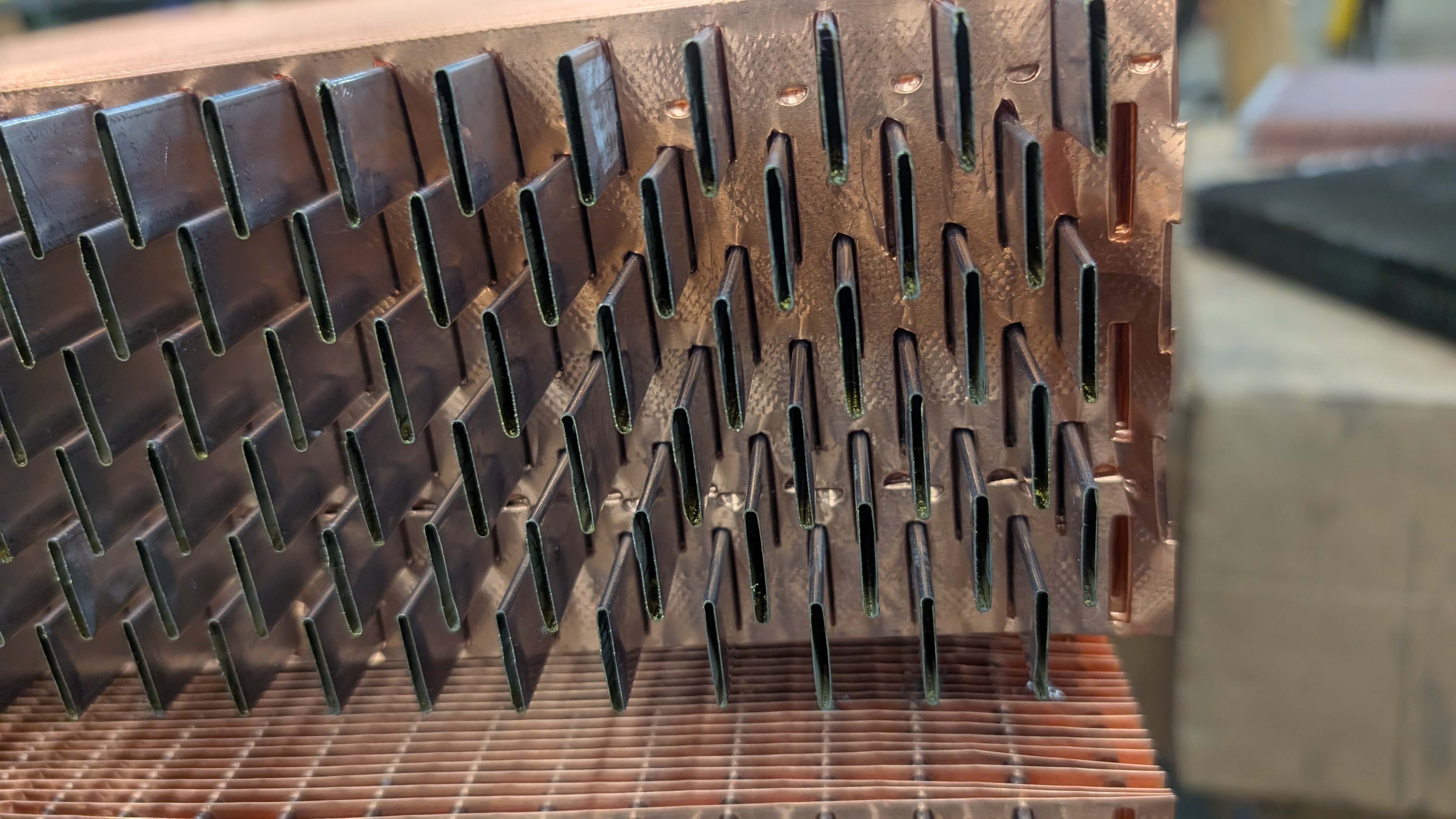
Why Should I Choose A Copper-Brass Radiator?
CB cores can be repaired, as they are soldered together, where aluminum cores are much harder to repair pinhole leaks. CB cores are not affected by electrolysis, so if you maintain the cooling system and flush it every 2-3 years, your radiator should last a very long time. The main reason to select a CB radiator is the appearance. If you want to keep the original appearance, then a CB radiator does that. U.S. Radiator can even re-core your original radiator with a modern core that has better flow but retains the original tanks, which is important for vehicles built in the 1950s and older, as the VIN and data plates were typically affixed to the radiator tank.
Why Choose An Aluminum Radiator?
Aluminum radiator cores have more rows of tubes with thinner walls, making them more efficient when compared to the same size CB core. “We can move more coolant in a smaller space with aluminum” Cochran told us, “If we leave it based on space alone, we go with aluminum.” That doesn’t mean that aluminum cores are perfect, they do need to be protected from electrolysis, which is an electro-chemical reaction that is present in every engine cooling system. The fix is to run a sacrificial anode in the cooling system. Aluminum radiators are difficult to repair, so when they fail it is a replacement job.
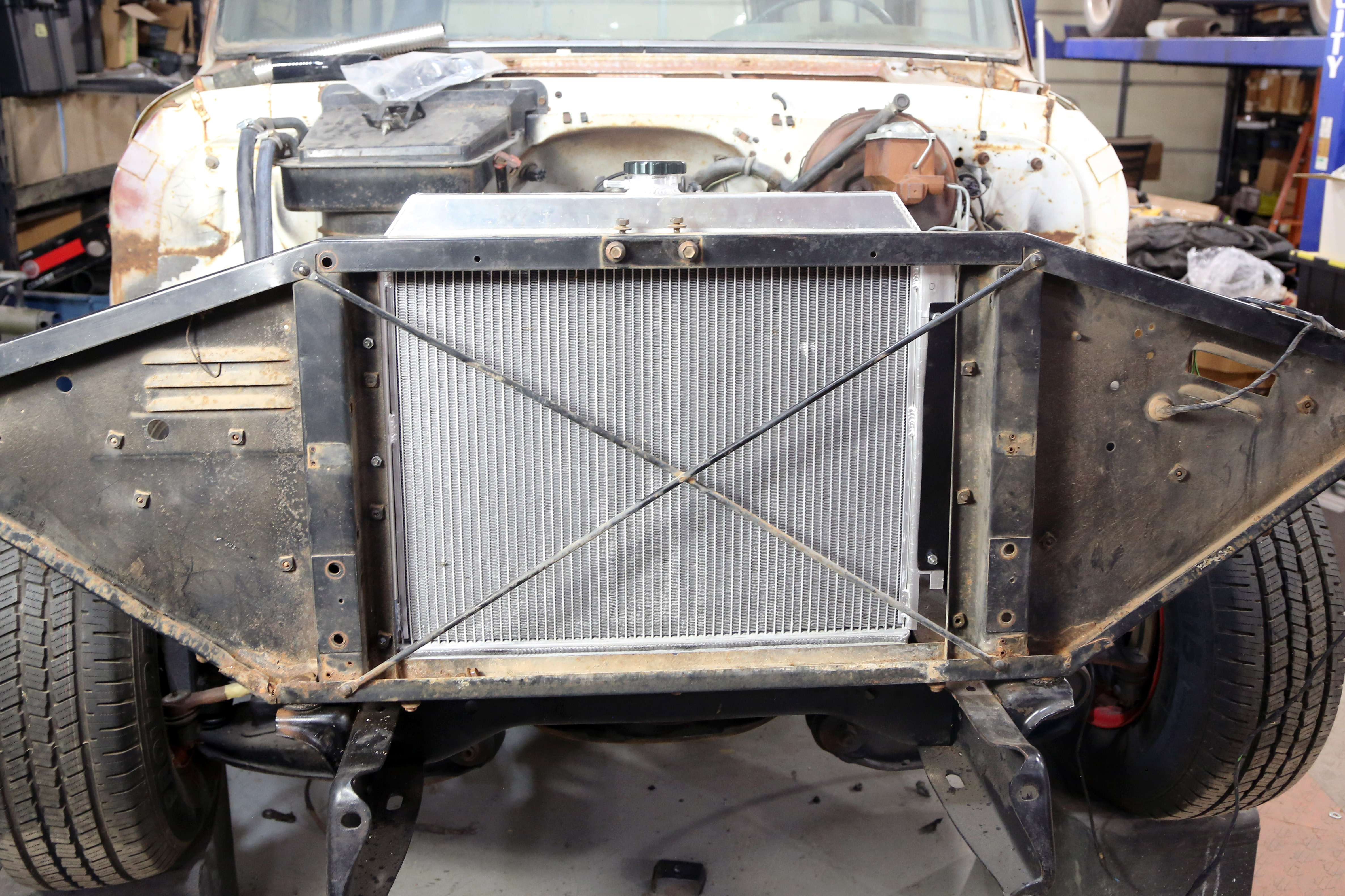
What Is The Difference Between Downflow and Crossflow Radiators?
Most radiators were downflow until the mid-60s, when OEMs began using crossflow designs, though many trucks kept the downflow design into the 1970s. A downflow design has tanks on the top and bottom of the radiator. Water flows from the pump to the top of the radiator, filling the tubes and flowing downward to the bottom tank, where it is pulled back into the engine. When comparing apples to apples, if the cores are the same size and design, along with the tanks, then there is not much difference in efficiency. Crossflow radiators have several benefits that downflow units don’t. Cooling systems are pressurized, and the radiator cap is there to manage the pressure. Downflow radiators can only have the cap on the hot side (where hot coolant exits the engine), so this is the highest-pressure area, allowing the cap to vent prematurely. This is a small benefit, but worth mentioning.
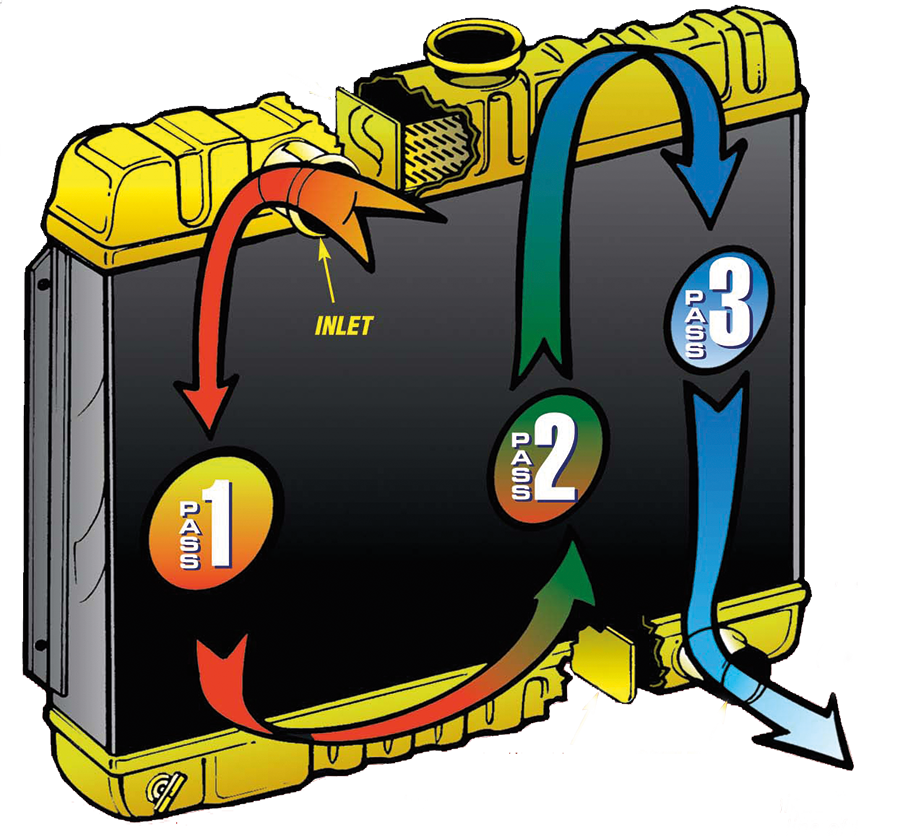
What Is A Dual or Triple Flow Radiator?
In many cases, you can order a new radiator that looks like a typical radiator but is divided internally into two or three sections. A typical radiator flows all the coolant through the entire core in one pass. A dual or triple flow core splits the core so that the coolant flows through each section of the core, giving the coolant more time to transfer heat, making it far more efficient. The U.S. Radiator Tripleflow option can drop engine temps up to 20%, which is a huge gain. If you have a hot-running engine, this could be the difference you need.
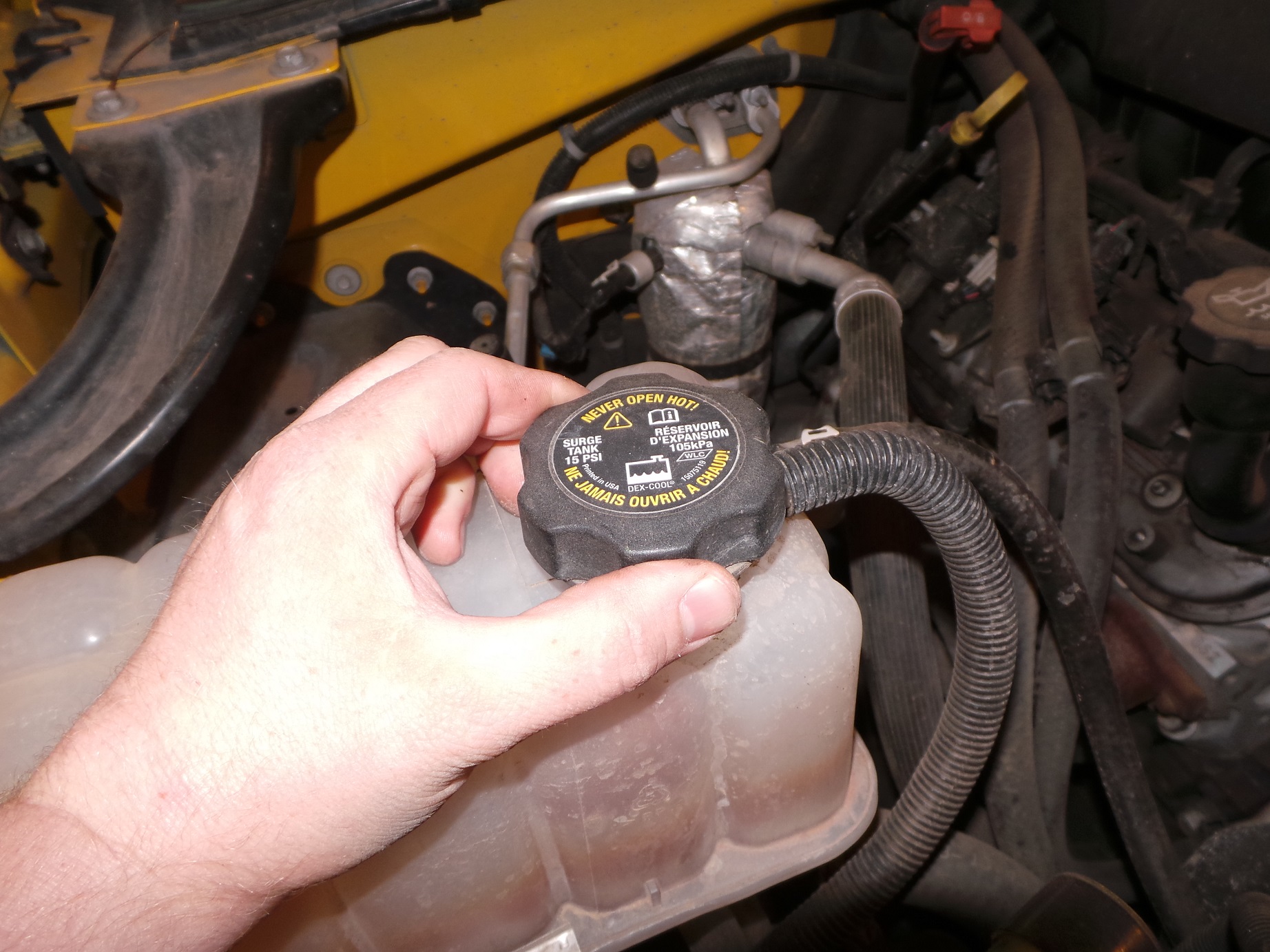
Why Are There So Many Different Radiator Caps?
If you have ever been to a parts store, you probably noticed about a million radiator caps. While some of this is due to OEMs not using a standard cap size (Asian cars have very small caps for example), there is also a difference in the pressure relief. Heat means pressure, and your cooling system has a limit on how much pressure it can contain; this is where the cap relief valve vents to purge that excess pressure. When you get steam pouring out from under the hood, that is the cap venting.
“How your cooling system pressure is managed is a critical component to the overall design” says Cochran, “Open or closed recovery systems change the pressures inside the main cooling system.” The first closed-loop cooling systems for automobiles came out in the late 1930s, but they were not standard until the late 1980s. Even GM has used both systems in the same model with different packages. For example, a 1968 Buick GS had a standard closed system, but that would be an optional accessory on a Skylark. There are different pressure rates for various engines and cooling system types. The most common are 15 PSI for closed systems, and 7-15 PSI for open systems. Some race cars use 20- to 30-lb. caps, but that is not for the street.
An open system vents to a bottle, can, or to the ground (not very environmentally sound!) and uses a single-seal cap. When the coolant pressure exceeds the cap rating, the valve opens, sending coolant into the overflow tank. Closed systems are much more efficient. These use a double-acting cap which purges extra pressure and draws reserve coolant into the system when it is cold. The tank on a closed system is an expansion tank, serving to maintain the coolant level in the system when hot and cold.
Why Does Radiator Cap Pressure Matter?
“A change in pressure of 1 psi results in a 3-degree change in temperature” says Cochran, “If your engine calls for a 15 PSI cap, but the one that is actually on the radiator is only holding to 7 PSI, you can see engine temperatures 27 degrees higher than you should.” The opposite is also true, as water boils at 212-degrees at sea level, but at 6200 ft, it boils at 200, this is the difference in pressure. While a higher-pressure cap will push the boiling point higher, the pressure inside the system can reach unsafe levels. Remember, the hoses, pump, and gaskets are under the same pressure and temperature, ballooning the hoses with higher pressures is a recipe for disaster. Another key point on caps- Stay away from the cheap overseas caps, buy a quality US-made cap so you can be sure it will actually vent at the correct pressure.
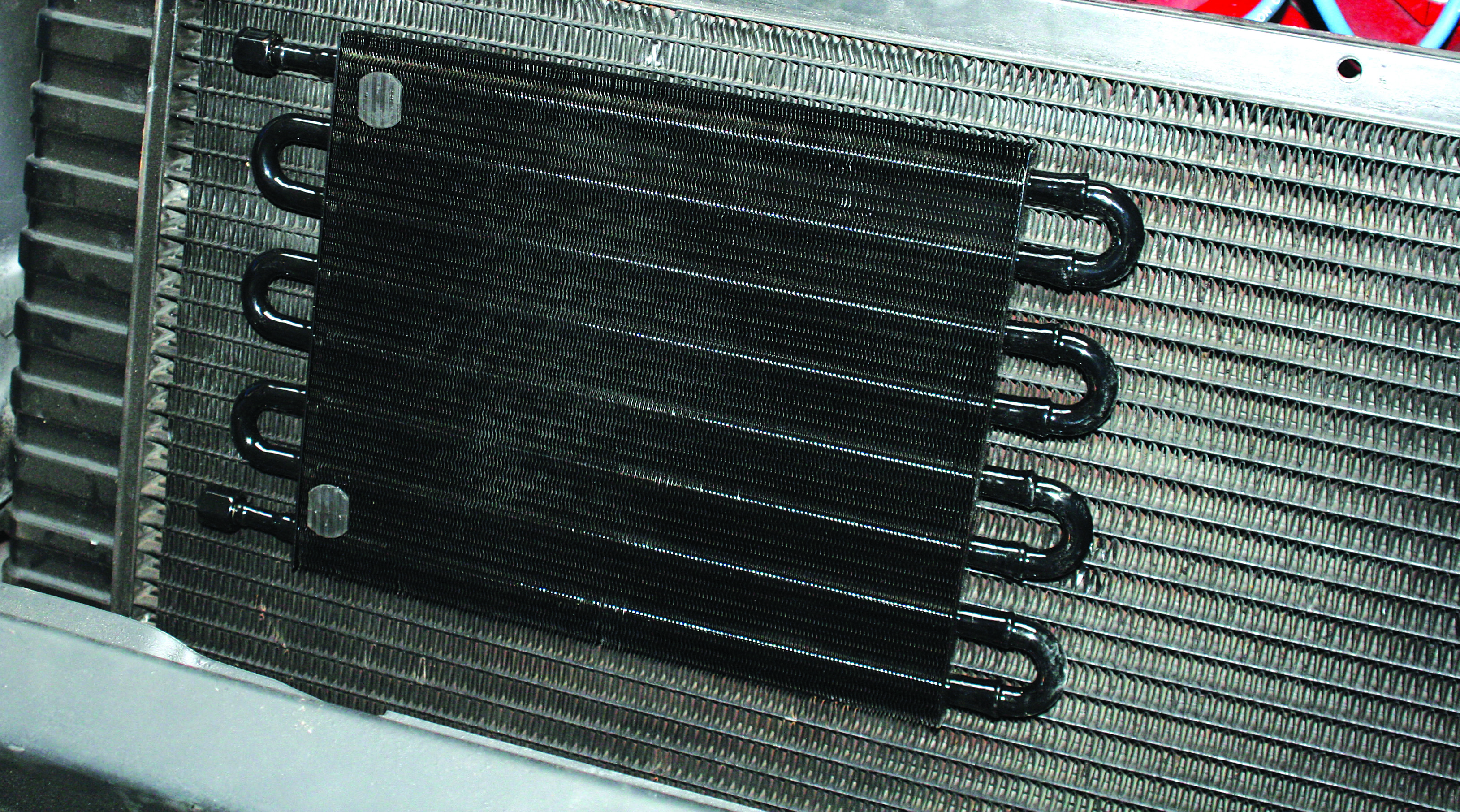
Do I Need An External Or Internal Transmission Cooler?
This is a common issue for gearheads, especially when swapping transmissions from manual to auto. All automatics need a cooler to maintain the 175-degree optimum running temperature. The best way to do this is to use an internal transmission cooler in the radiator. The reason for this is that transmissions do not like cold temperatures, ATF is much thicker at room temp than at 175, in fact AFT doesn’t thin out to the correct viscosity until it reaches 160 degrees, so if your transmission is running colder than 160, the fluid is putting more strain on the valves and seals. An internal cooler helps bring the ATF temp up faster so that your transmission is running at the optimum temperature.
External coolers are unregulated, so they will cool as much as possible, often taking the temps too low. If you are experiencing higher transmission temps or tow, then you may need both. An auxiliary cooler mounted after the internal cooler to reduce the fluid temps a bit more before they go into the transmission.
Why Not Run An External Transmission Cooler On The Radiator?
The main reason is that it increases the stack-up in front of the radiator, inhibiting the airflow through the core. Imagine a modified muscle car with AC (condenser in front), auto trans (cooler behind AC condenser) and then the radiator core, that is a substantial stack in front of the core. You can easily block 1/2-2/3rds of the core with these two alone, not to mention that the air that flows through the core is now much hotter than it would have been. Then let’s add an intercooler for boost, which goes in front of all of the rest, so you have a lot of mass reducing flow. Internal coolers are more efficient and reduce the overall stack-up, which is why they are recommended.
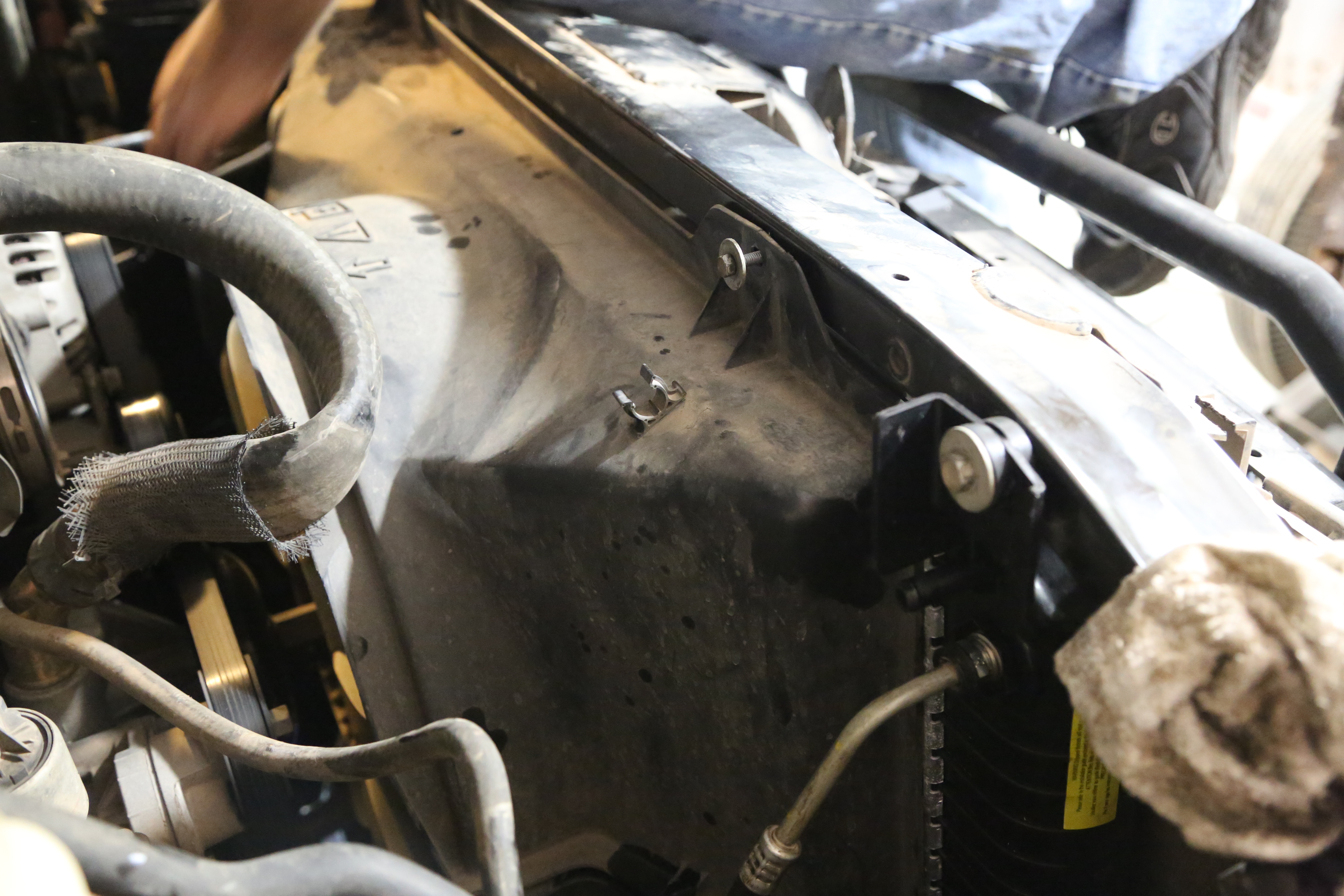
Do I Need A Radiator Cooling Fan?
Moving beyond the radiator, the rest of the system is just as important. The biggest mistake many gearheads make with their cooling system is the fan. Mechanical fans are just fine, but they eat horsepower and are not controllable. Electric fans are the best option for any car that is not restrained by originality. Regardless of the fan style, all fans should be shrouded, especially mechanical fans. Without a shroud, a mechanical fan is just stirring up the air around it, there is little draw through the radiator at all. With a shroud, the fan generates a vacuum, pulling air into the radiator. This is only important below 40 mph, once the vehicle is moving 40 or faster, the natural airflow takes over.
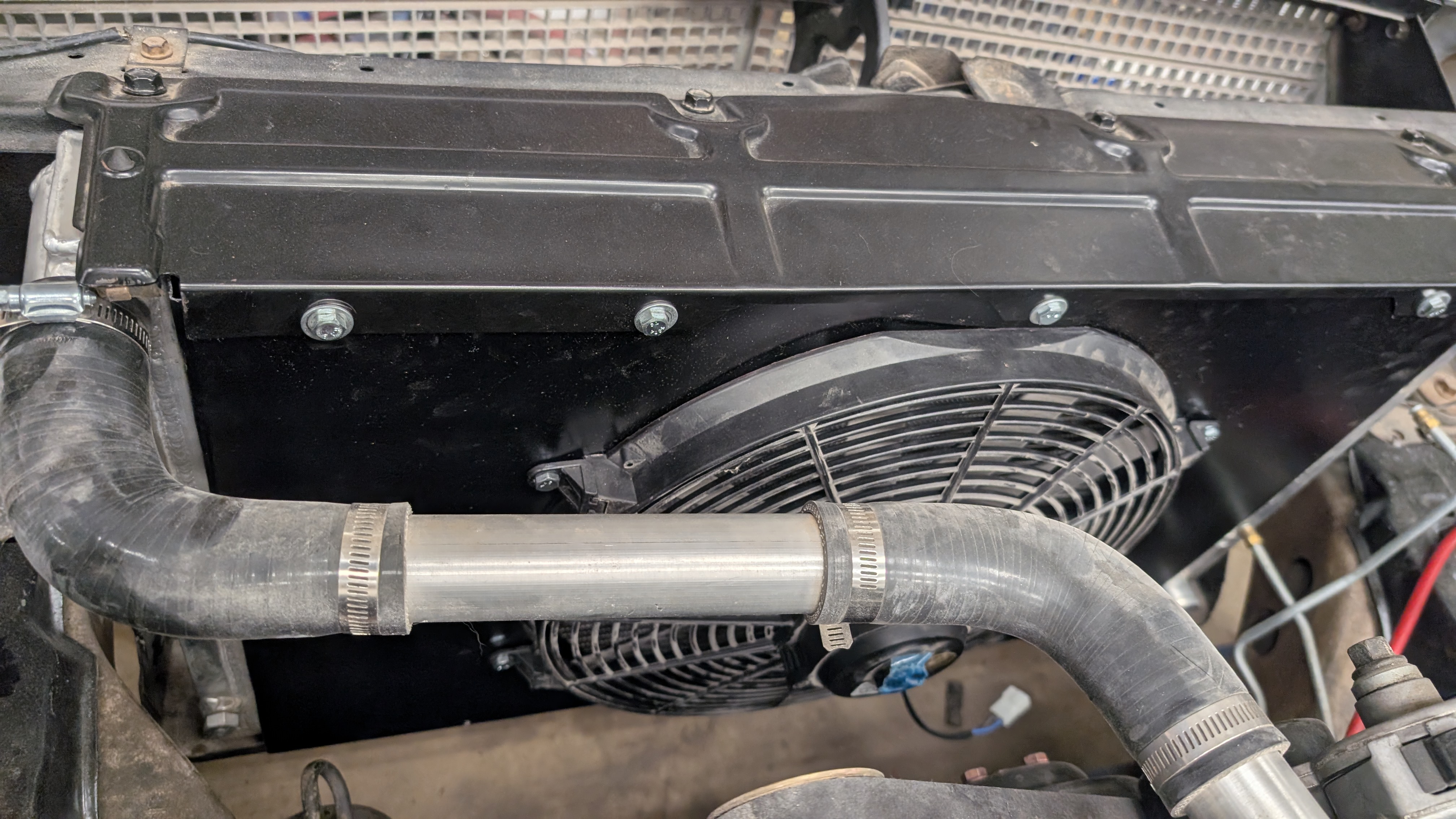
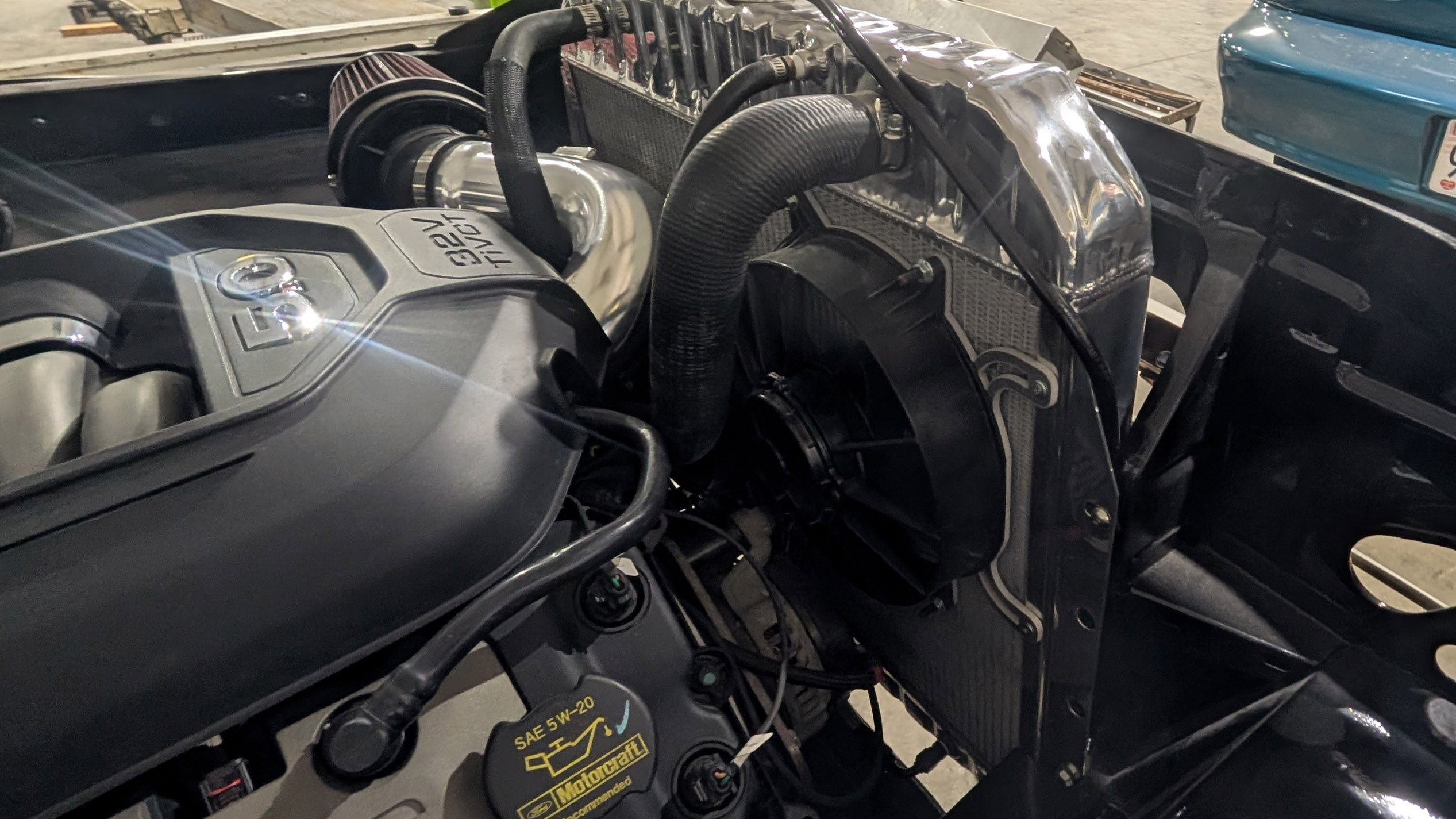
Electric fans should be shrouded as well. The recommended distance between the fan and the radiator is 1-2”, with a full shroud covering the entire fan-side of the core. This forces the air through the entire core instead of just the area directly in front of the fan. It is very common to see electric fans mounted to a radiator with special zip ties, while this works, it will eventually rub a hole in the core. A shroud is far better, but a fan ring is the suitable solution for tight-fit vehicles where a shroud is less feasible. Fan rings mount to the perimeter of the radiator, eliminating the risk to the core.
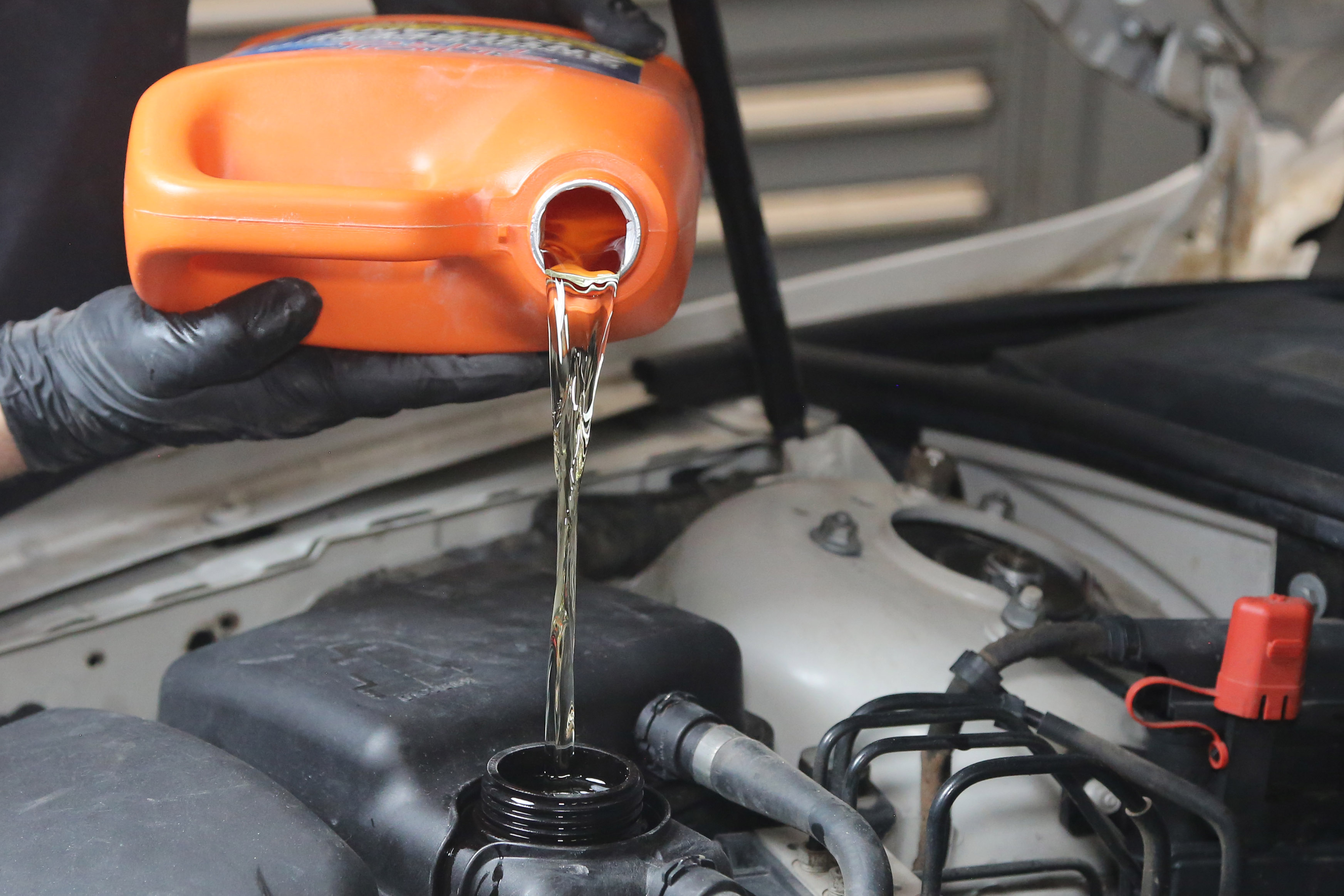
Is There Really A Difference In Coolant Types?
There are many formulations for coolant as each manufacturer has their specific formulations, however in the United States, there are three main type of engine coolant: Original Green Inorganic Acid Technology (IAT), Organic Acid Technology or OAT-Based, and Hybrid OAT G-05 and G-11 coolants. You may ask “why does this matter to me, I have a 1970 Chevelle, the old green stuff is fine.” If you have the original engine, then sure, you would be right, but if you have LS swapped that Chevelle?
IAT (Classic Green) coolant is silicate-based ethylene-glycol. It is very good at what it does, but for a very limited time. IAT coolant is good for 2-3 years, after that it doesn’t work well too resist freezing and begins to eat the rubber in the hoses and seals. It is highly recommended than any engine using IAT coolant be flushed every other year with a chemical flush and then refilled with fresh coolant. Remember, IAT coolant is toxic to all living things, so dispose of it properly.
IAT coolant does not mix well with aluminum, over time the coolant will eat away at the aluminum, including the radiator, block, and heads. This is the main reason OAT coolants were developed. If you have an aluminum radiator, you should be running OAT or HOAT coolant.
OAT coolant goes by many brand names; one such name is Dexcool. While Dex was named the culprit by shade tree mechanics in a massive recall by GM in the 1990s, the actual issue was an incompatible plastic used for gaskets. The coolant melted the plastic over time, but Dex got the blame. GM still uses the exact same OAT coolant; the gaskets were changed. This stuff has longer life, up to 10 years, but we still recommend flushing it every 3-4 years, as OAT coolants do not like air, and will sludge up over time. This is the reason that all modern vehicles have fully sealed cooling system with no vents on the expansion tanks. OAT coolant does not like copper-brass, so if you have an older vehicle with a CB radiator, IAT is going to be the best choice.
The newest type of coolant is HOAT. Because IAT and OAT coolants can NEVER be mixed (they turn to sludge immediately), a hybrid coolant was developed, using a little of both technologies. Most OEMs use HOATs now (GM is the odd duck, sticking with Dexcool). With a solid 5-year lifespan, you can safely use HOAT coolant in place of either type for 5 full years. This is the “All-Makes” coolant you see at the store.
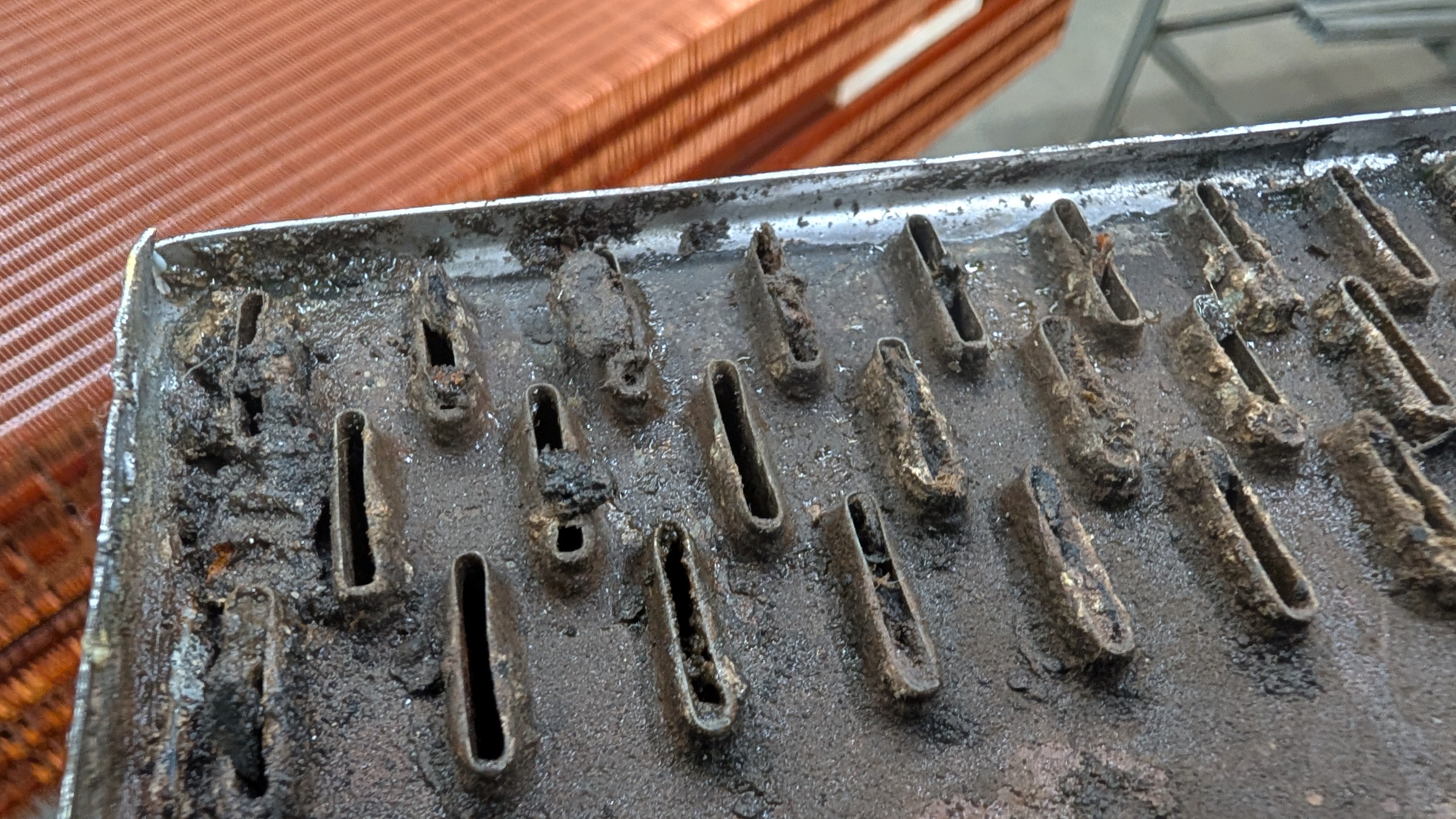
Tap Water Is Good Enough, Right?
NOPE. While just about every one of us has done it, filling your cooling system with tap water is a terrible option. The minerals in tap water create all kinds of havoc, including sludge, corrosion, crystalline formations, and some even become acidic when mixed with phosphates. Many import coolant formulations such as Honda and Toyota use heavier phosphates, hard water (high in calcium and magnesium) reacts very poorly with phosphates and can severely damage your engine over time. Tap water is also a major contributor to electrolysis in cooling systems. You should only use distilled water mixed 50/50 with the proper coolant. Better yet, you really should consider buying pre-mixed coolant, which ensures that you are getting all the good stuff and none of the bad stuff and you don’t have to mix it. Yes, You are “paying for water,” but it is the right water. Your Brita filter is not good enough; you need chemically pure water to avoid the contamination.
My Engine Is Running Hot, Can I Just Run A Cooler Thermostat?
This myth is one of the worst there is, as the thermostat does not have any control over the operating temperature of your engine. Your engine is going to run as hot as it is going to run based on the cooling system parameters. A properly designed system will maintain the temperature in a safe range. The only thing the thermostat does is open and close at a specific temperature, it is actually regulating the minimum temperature, not the top end. A 160-degree Tstat begins to open around 135-140 degrees and is fully open at 160. When the temps fall below 160, the Tstat begins to close until the temps rise again. If you have too high of a tstat, your engine will get up to temp faster, but you are closing off some of your cooling range, going to a cooler temp unit will only open the flow faster.
There are reasons to run a higher or lower thermostat, such as you want to be able to use the heater sooner from a cold start, or your engine needs to get up to a higher temp faster. Most modern engine ECMs don’t even turn the fans on until the engine is at 205-degrees, so going from 190 to a 170 tstat won’t do a thing to reduce the operating temperature unless the previous tstat was higher than the cooling system’s efficiency.
AS you can see, there is a lot more to cooling systems than just the raw parts, every piece of the puzzle needs to be compatible, from the radiator to the coolant and water you use. This article is a “5,000-foot view” of engine cooling systems. You can learn more on each of the above sections by clicking the links in the text above for each section. Gearheads spend the most money on their engines, why would you put it at risk by running the original 6-cylinder radiator and tap water?
The post Everything You Need to Know About Automotive Cooling Systems appeared first on The Online Automotive Marketplace.
